If you're looking for a fast, inexpensive single LTE radio router with an excellent user interface, the Teltonika RUTX11 might be for you.
In the last few years, there have been a lot of new, affordable LTE routers showing up in the market. Many of the manufacturers have had products in other markets such as IoT and manufacturing, which is the case with Teltonika. They have been around a long time and have a big background in IoT and manufacturing with products spanning modems, switches, routers, and gateways.
A couple of readers mentioned a newer platform that Teltonika came out with called the RUTX11. It was hard to get initially, but I was able to get mine from a niche US wireless vendor. It appears it is available on Amazon now, and if you purchase it using the link above, it helps support my site.
Since the release of the RUTX11, they have come out with the RUTX12 which is a dual LTE CAT6 version, and the RUTXR1, a rack mount version with dual power supplies and a single LTE CAT6 radio. Unfortunately I could not find the RUTX12 easily in the US, but from what I can tell, the only difference is two LTE modems.
The biggest challenge with these products is the CAT6 modem which is almost 6 years old. While they are still good modems, they don't support all of the new bands and features of the more prevalent CAT12 or even the newer CAT18 modems. The newer band support is probably the biggest advantage they have, as providers like T-Mobile and AT&T leverage them for longer reaching signal and more coverage in areas that didn't have it before. However, they will work reasonably well in most situations.
Specifications
Some high level specifications are below. A detailed list is available in Teltonika's datasheet.
Hardware
- Single LTE category 6 radio
- Supported bands: B2, B4, B5, B7, B12, B13, B25, B26, B29, B30, B66
- Dual SIM slots
- Dual band 2.4Ghz / 5Ghz WiFi
- 1x Ethernet WAN port
- 3x Ethernet LAN ports
- USB port for file sharing
- 9-50 volts DC power supported
Software
- OpenWRT-based software
- Very nice web interface
- Lots of VPN choices
- Management and monitoring options – lots of them!
- Other protocols like MODBUS, MQTT and more
- Remote management via Teltonika's cloud solution (RMS)
Unboxing and Setup
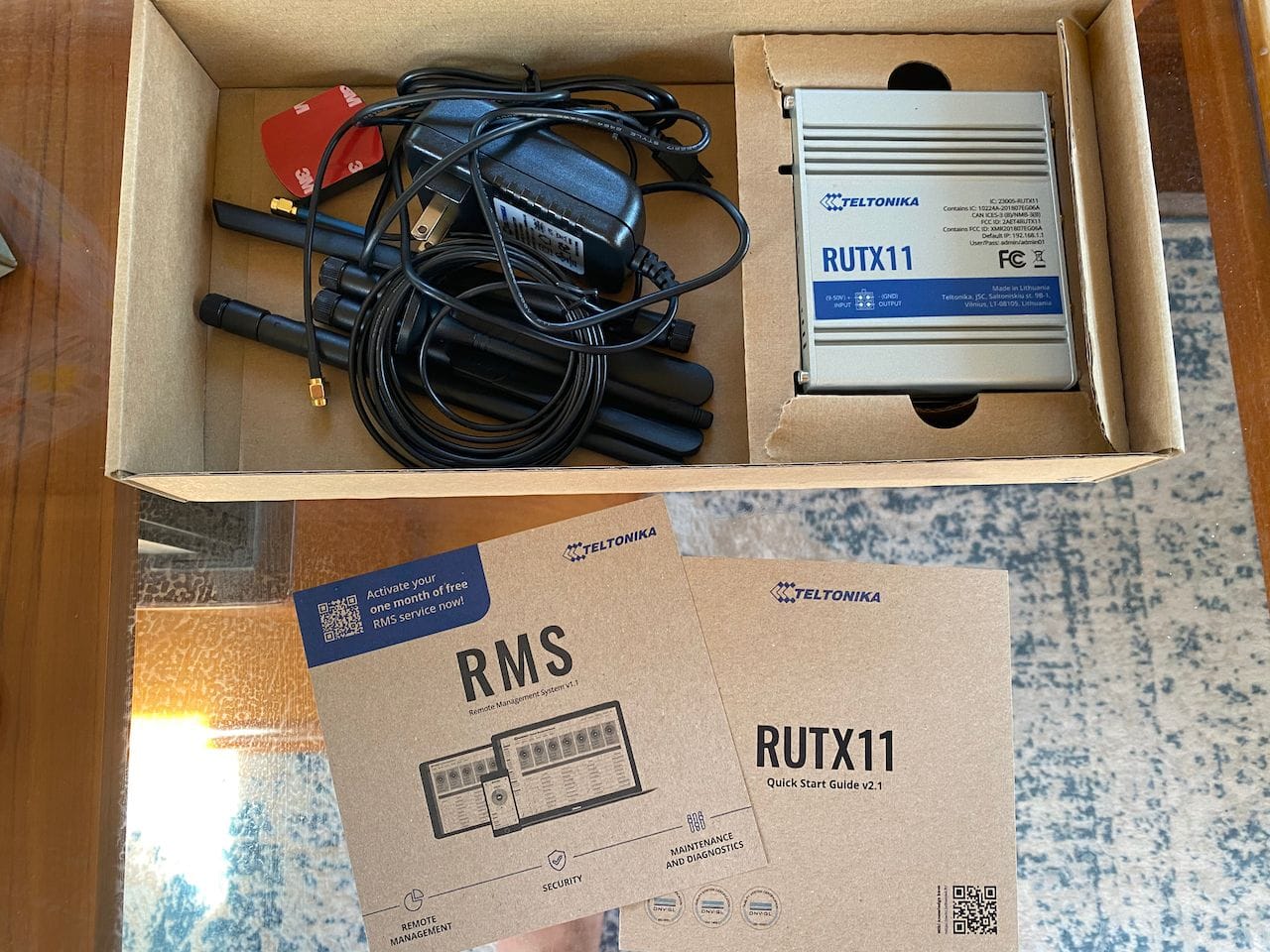
The box includes the router itself, a wall wart power supply with funky connector, 2 WiFi antennas, 2 LTE antennas, 1 GPS antenna and 1 Bluetooth antenna.
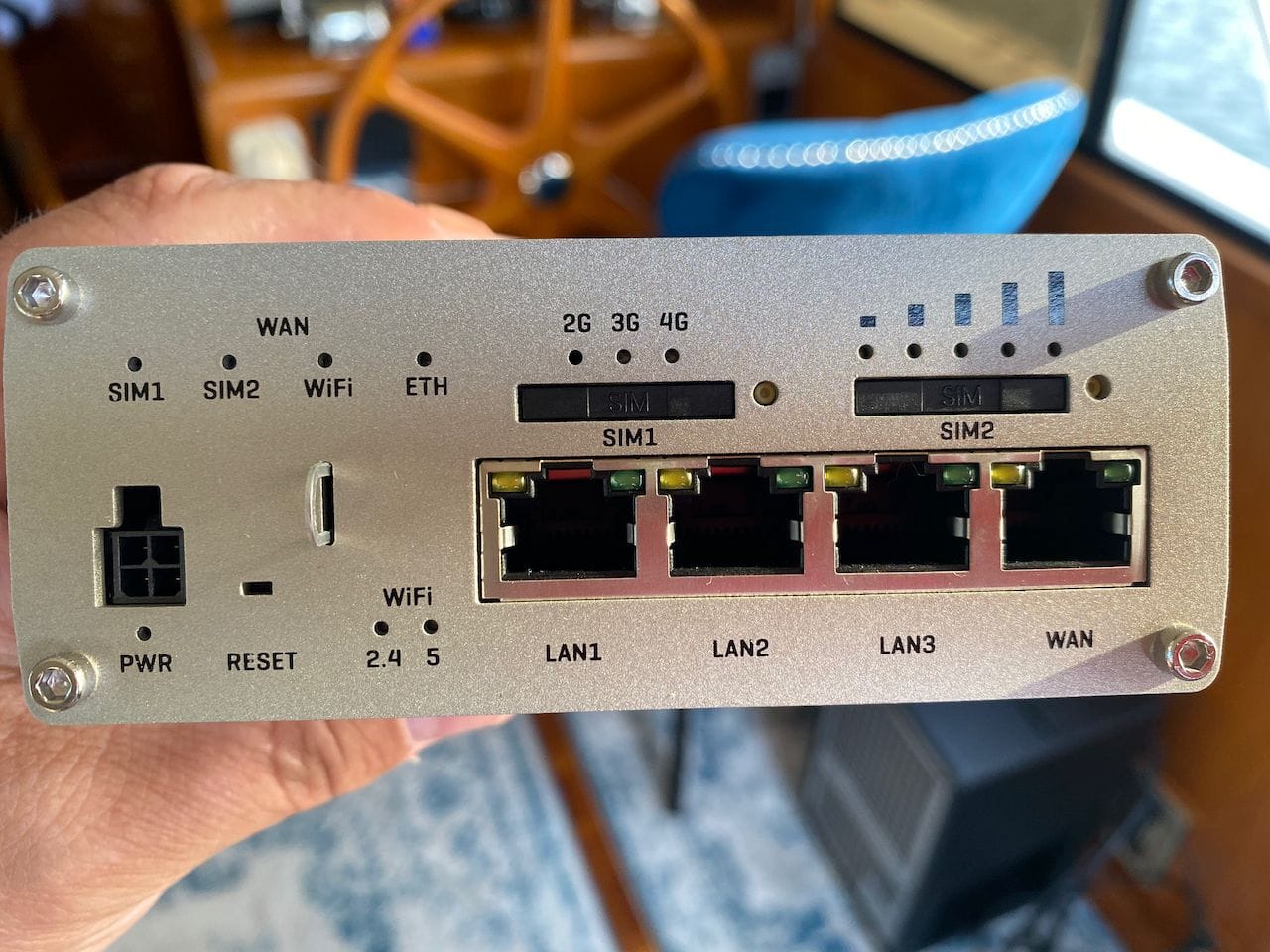
The front of the router has a lot of lights for everything from the SIM card status to the LTE level (nice!) and more. There's also 4 ethernet ports, 3 LAN and 1 WAN, plus SIM slots and an actual included SIM card remover built right in.
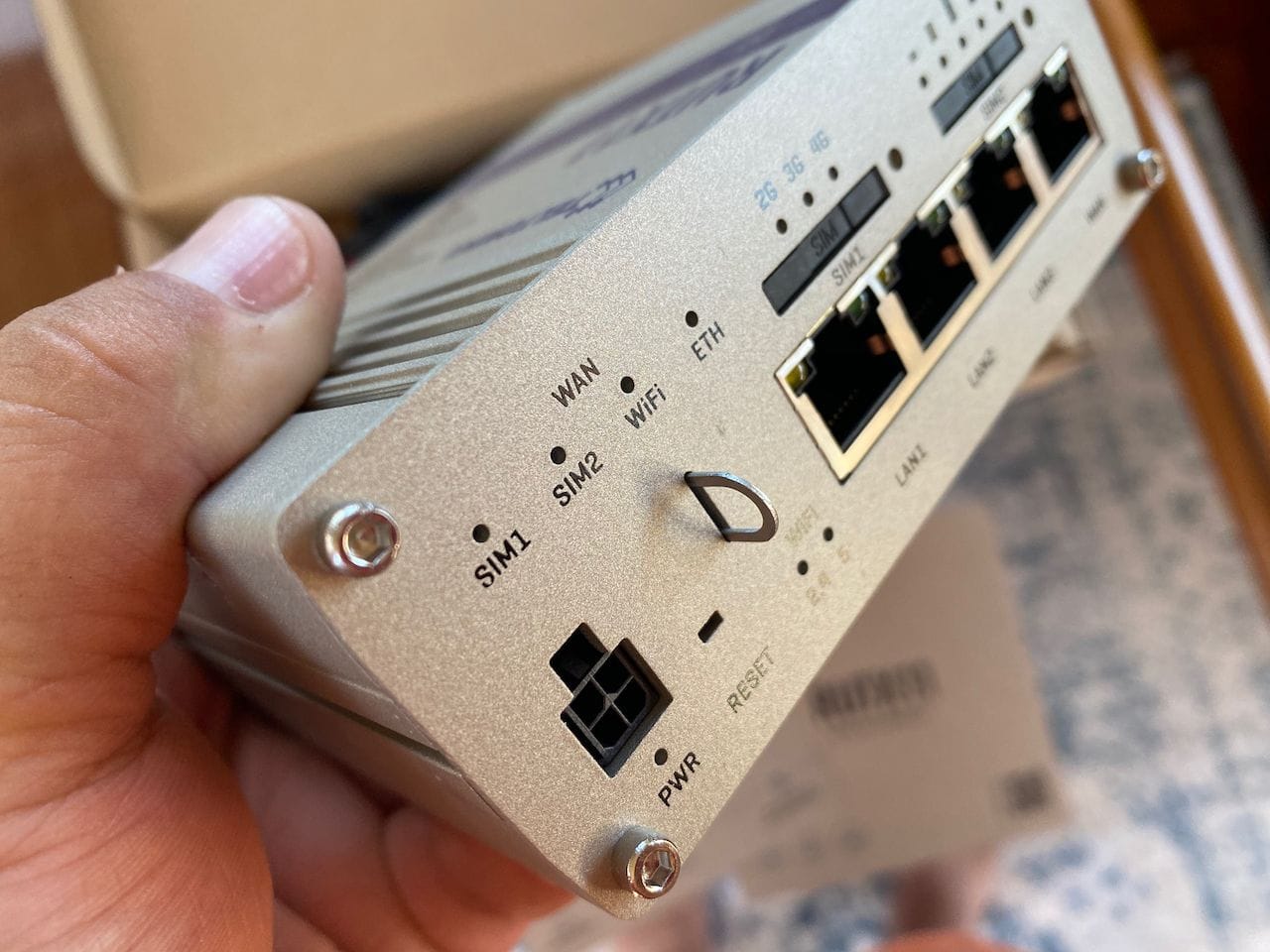
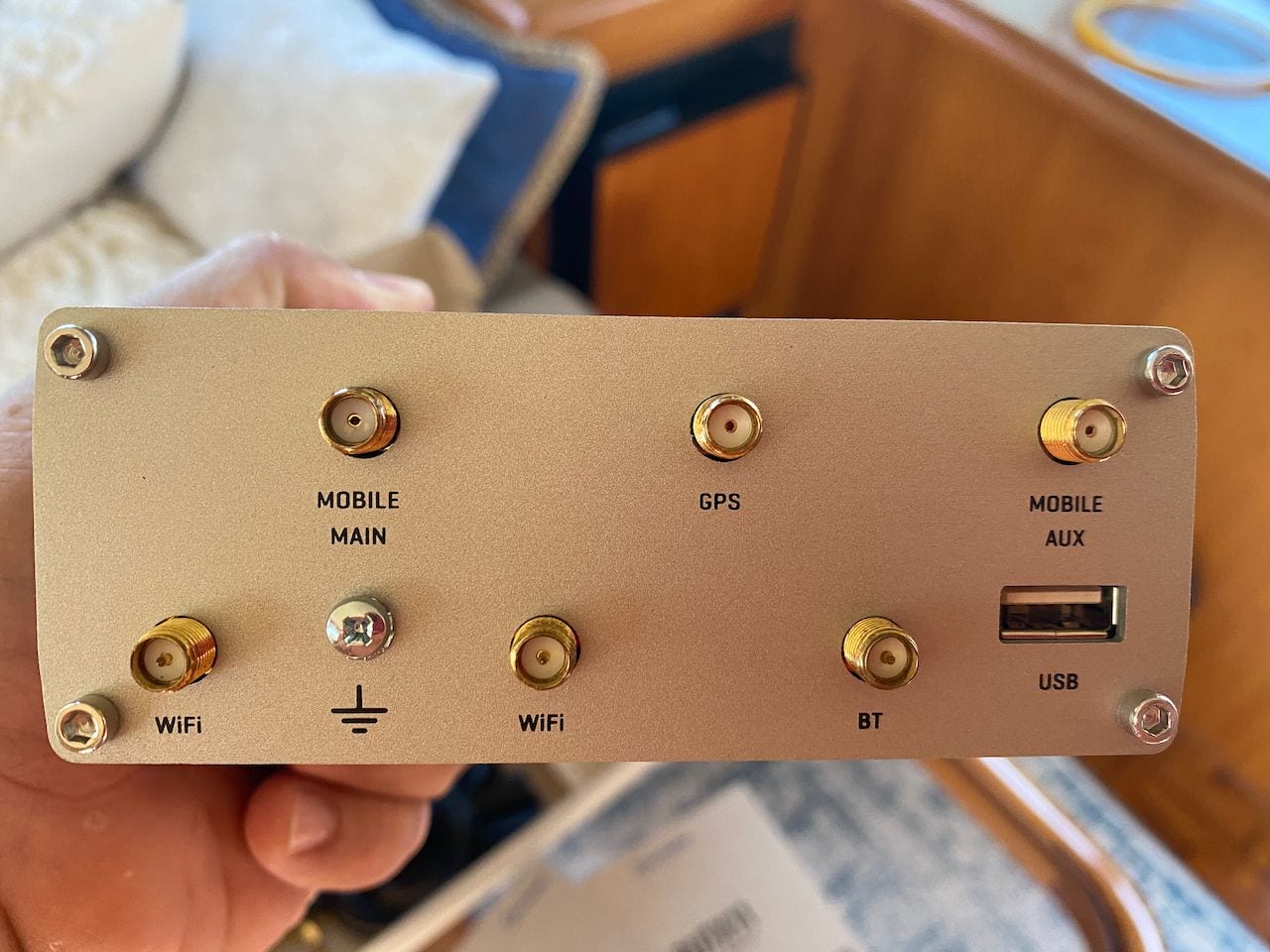
The back has antenna connectors for 2.4Ghz and 5Ghz WiFi (frequency not labeled), primary and secondary mobile antennas, GPS, USB, and Bluetooth.
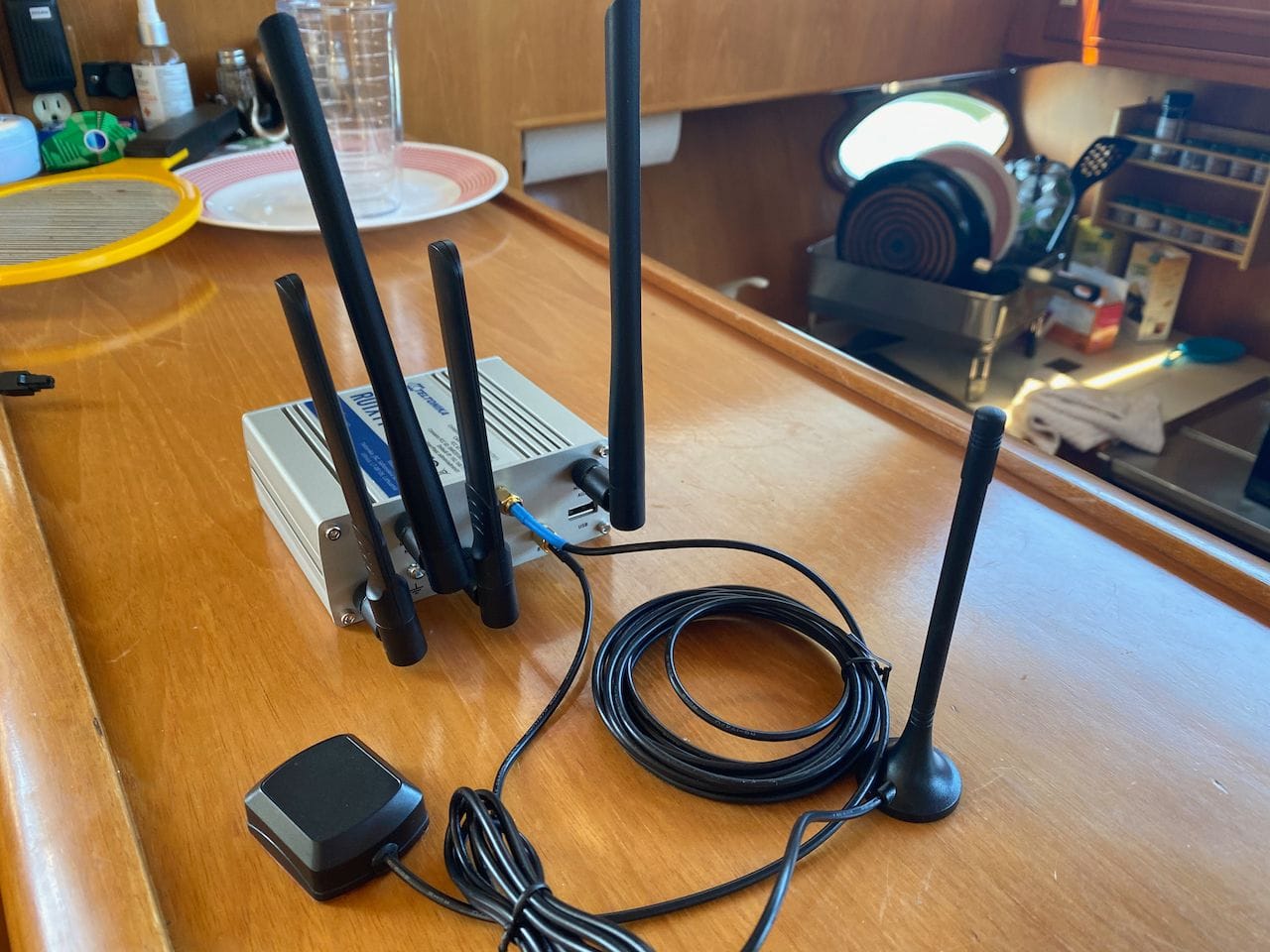
For a small router, there are quite a few antennas all in a compact area. I like the size and quality of the LTE antennas – they are 3-4″ longer than most I see with routers. The GPS antenna is on a nice long lead, as is the Bluetooth one.
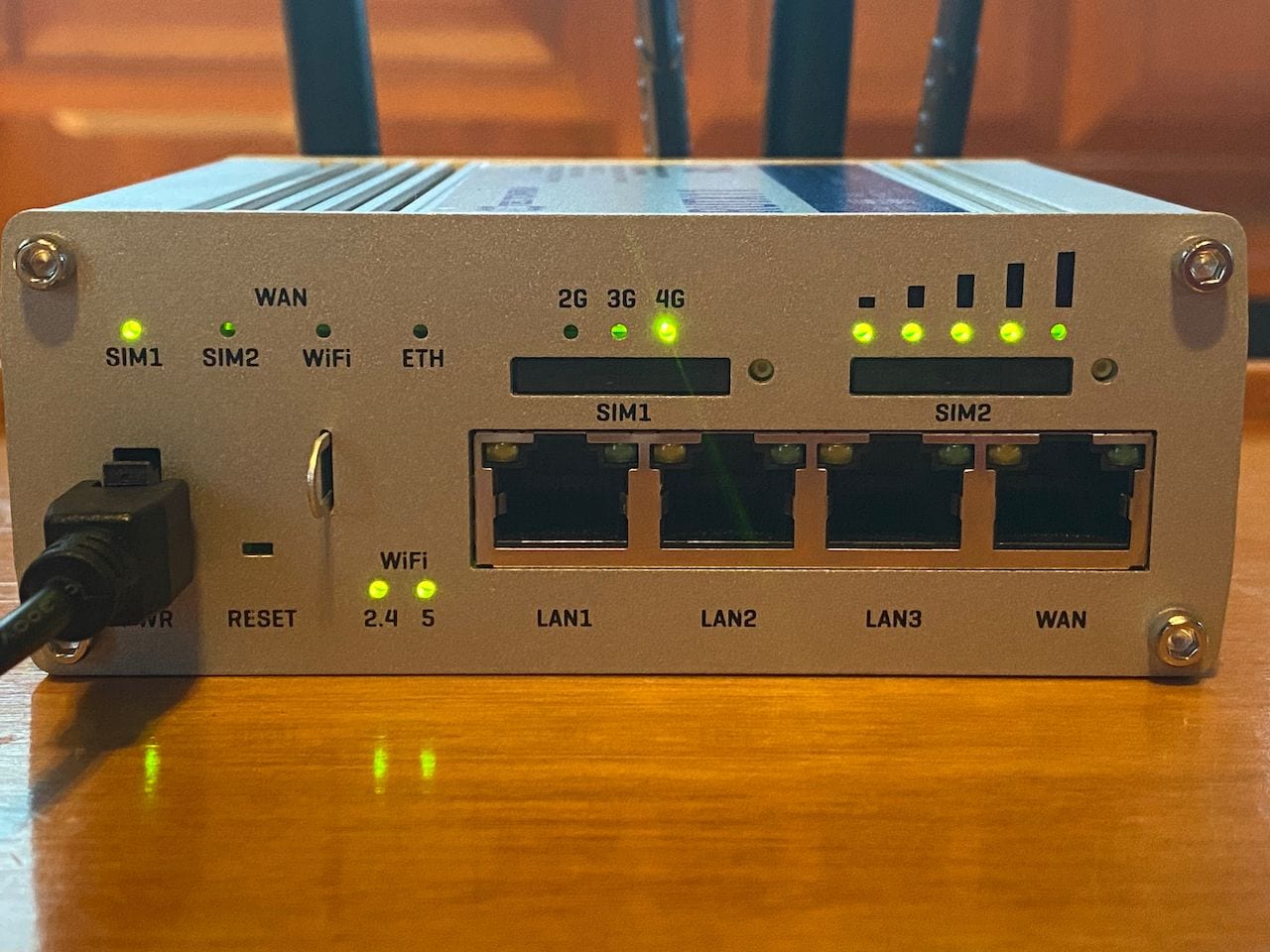
The LEDs on the RUTX11 are very nice and bright, and give you a clear indication not only of what is on, but signal levels, LTE type, and more.
I did not use the Bluetooth radio for anything, although it appears you can query data from the devices that are connected to it using UBUS command line tools. I suspect this could be useful in an IoT situation where you have temperature or environmental sensors that the RUTX11 is connected to, and you can query them and take some sort of action.
Software & Documentation
Teltonika have one of the best user interfaces and documentation setups I've seen in a while. Peplink is one of the best out there, but there are parts of Teltonika that I prefer, especially their wiki based documentation on the RUTX11. They keep it updated as things change, and it's searchable and very well written, complete with detailed configuration examples and more.
The software itself appears to be based on OpenWRT, which is an open source router software. They've added their own web interface which is quite a bit beyond the GL.iNet Amarok I reviewed earlier this year. The RUTX11 is far easier to use with more functionality.
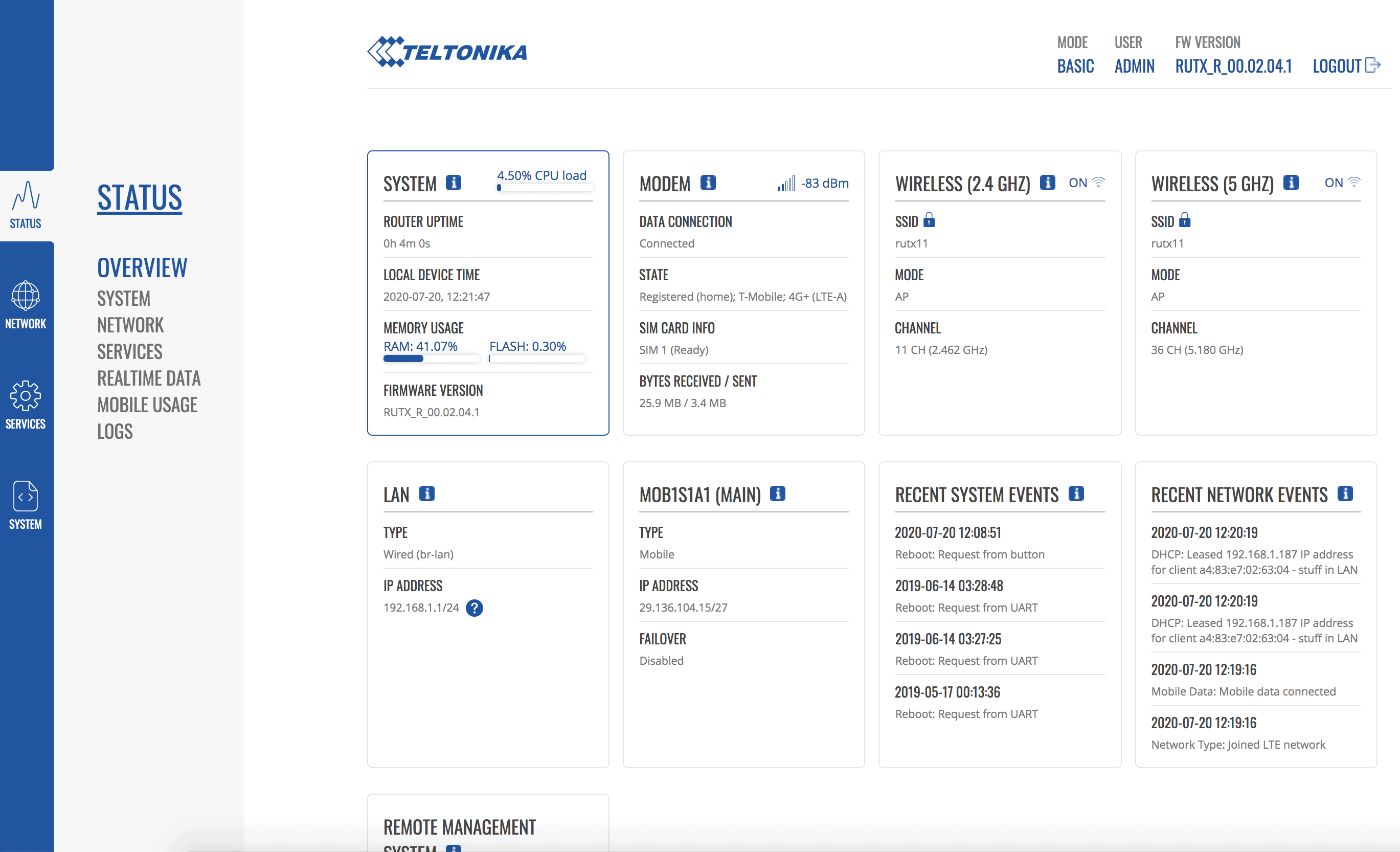
The web interface is very well laid out and extremely fast. In fact, booting up the router is amazingly fast even compared to more expensive models from other vendors, which is very nice. The dashboard contains a ton of information on all of the different parts of the router, and you can reorganize it to your liking, which is a nice touch.
There is a Basic and Advanced mode in the interface, and I kept it focused on the Basic mode for most of this article. Turning on Advanced mode gives you even more menu options and details on the individual screens as well.
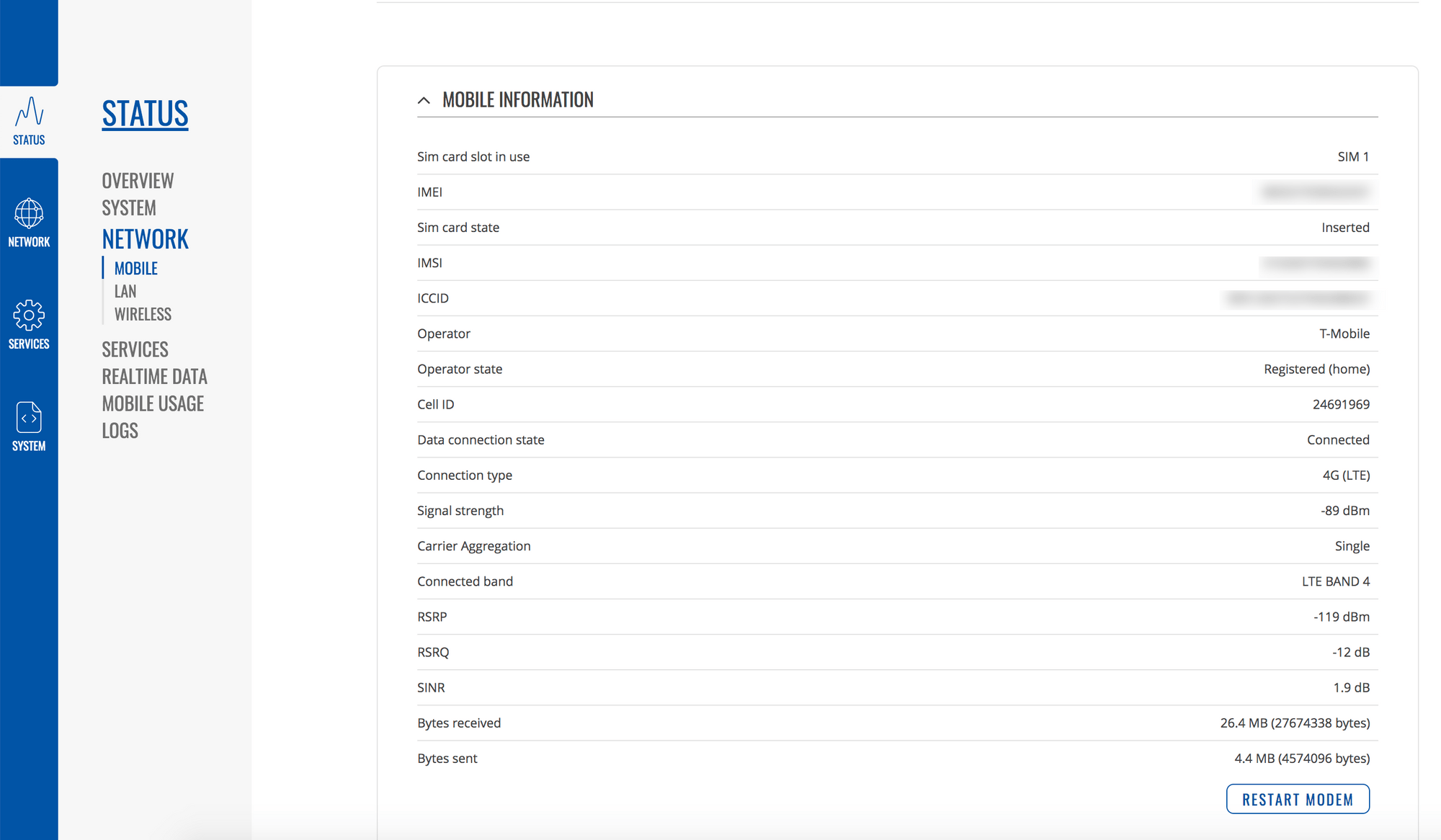
There are a bunch of good status screens where you can delve into more detailed information, including the one above for mobile network. Here you can see I am connected to Band 4 with an OK signal and I can even restart the modem if I want.
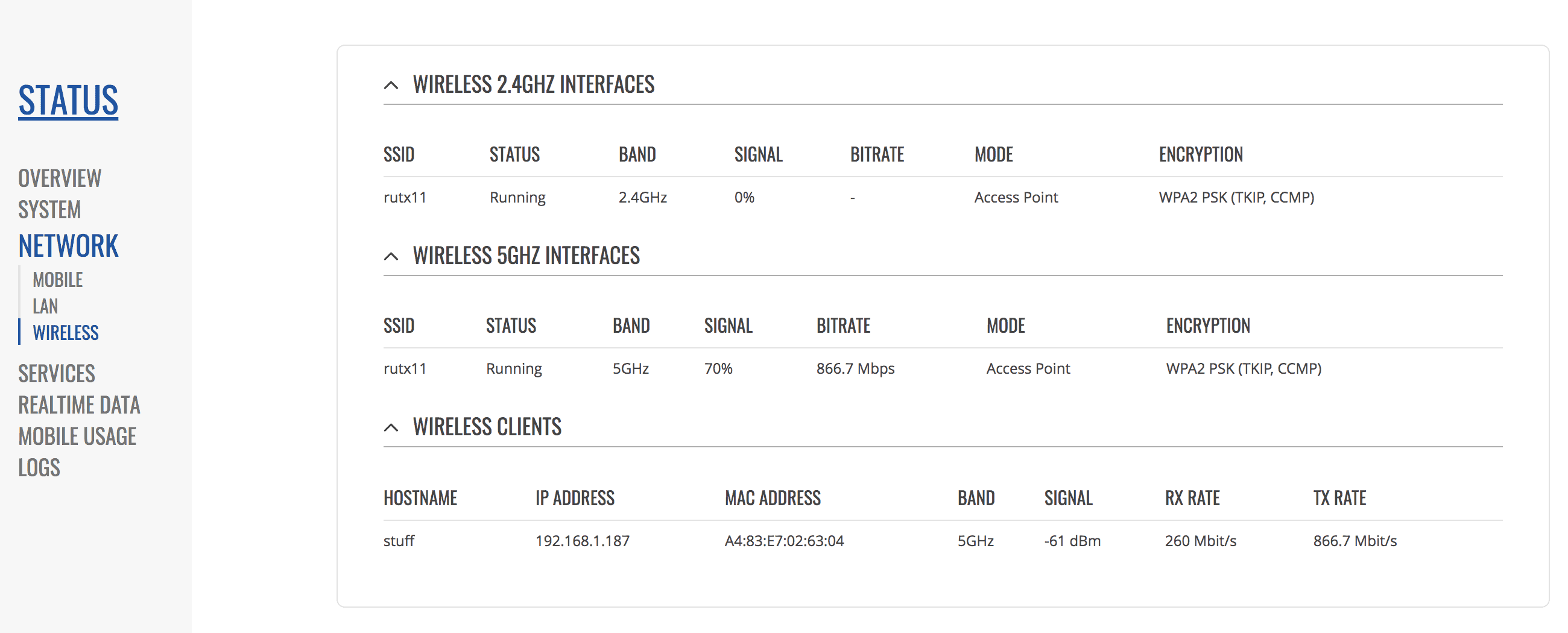
The wireless status screen also shows a bunch of useful info on the 2.4Ghz and 5Ghz radios, as well as clients that are connected.
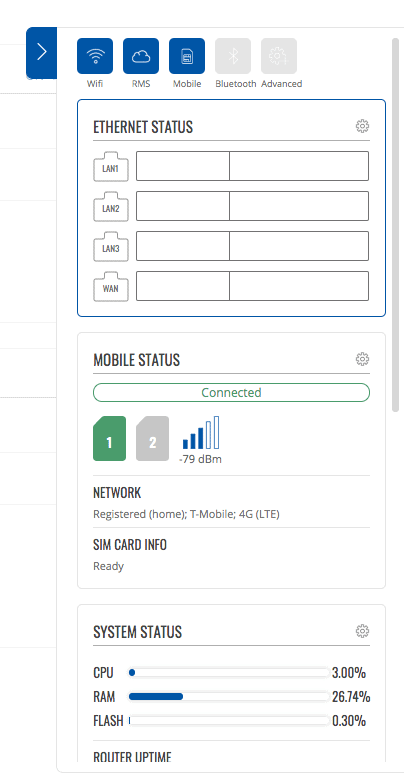
There's even a nice little popout display that shows everything in a compact dashboard that you can leave on the side of your screen.
Overall there are lots of detailed status screens – both the high level dashboard and the detailed drill downs – to find out what's going on very quickly.
Network Settings
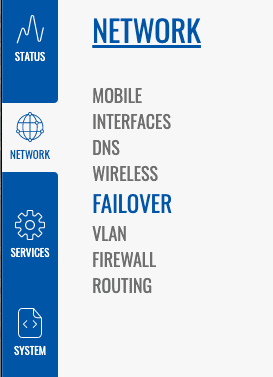
The network portion of the product is very configurable. Not only are there sections for the mobile and WiFi side, but you have a full firewall, VLANs, routing, and failover options.
Note that some of these screen shots were taken with a previous firmware version that does not show some of the newer features that were released in the menu on the left hand side.
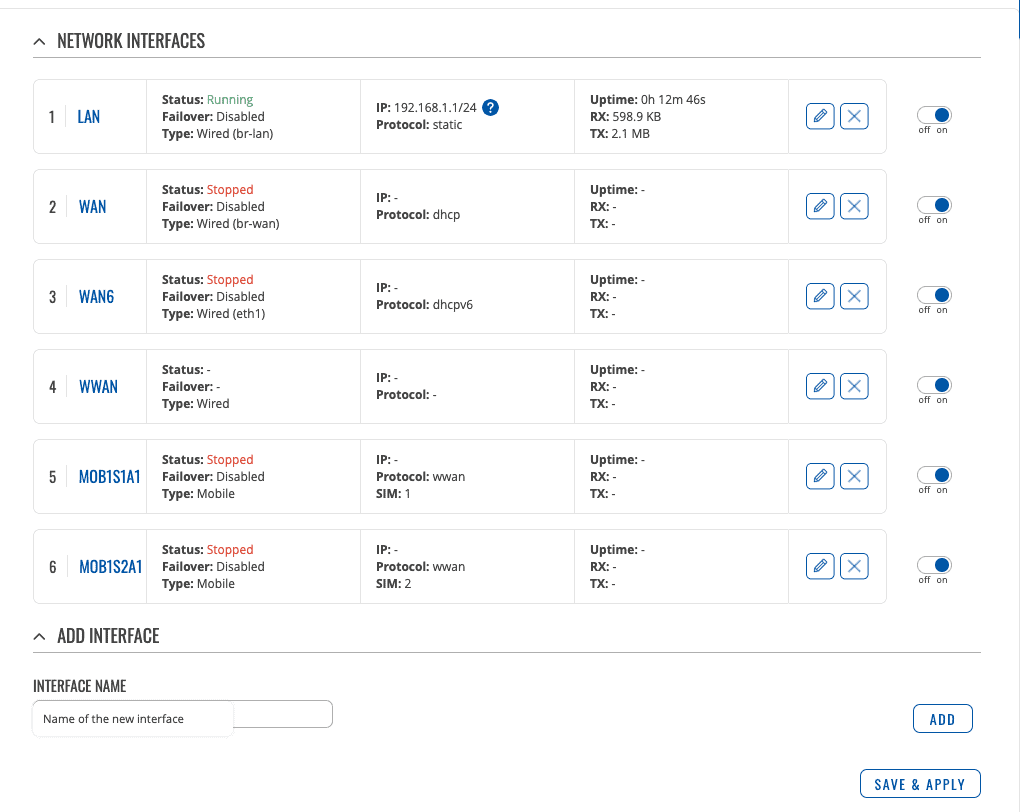
The one area I found a little confusing is the network interfaces screen. This is where some of the OpenWRT underpinnings leaks through, I believe, in particular with the names of the interfaces. For instance, WAN and WAN6 threw me for a moment until I saw that WAN6 is using dhcpv6, which is only used for IPv6. If that doesn't mean anything to you, then don't worry about it – it's a newer form of addressing. Nevertheless, it is confusing to have two WAN interfaces, as well as the weirdly named mobile interfaces below that.
The biggest challenge I had with the Teltonika was here – with the WAN port. I wanted to connect it to my existing on board network via ethernet using the WAN port, and it took a while to figure out how to edit it to start it up on boot, get it to grab an IP address, etc. This seems to have improved in later firmware versions, but could trip an average user up. Thankfully their documentation is excellent.
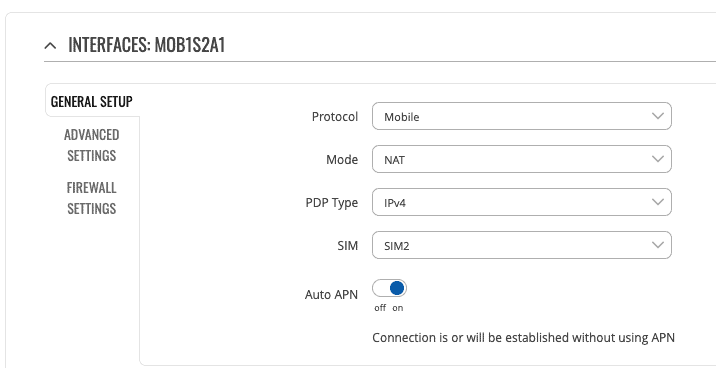
Each interface has different settings depending on the type of interface – mobile ones are different than WAN, etc.
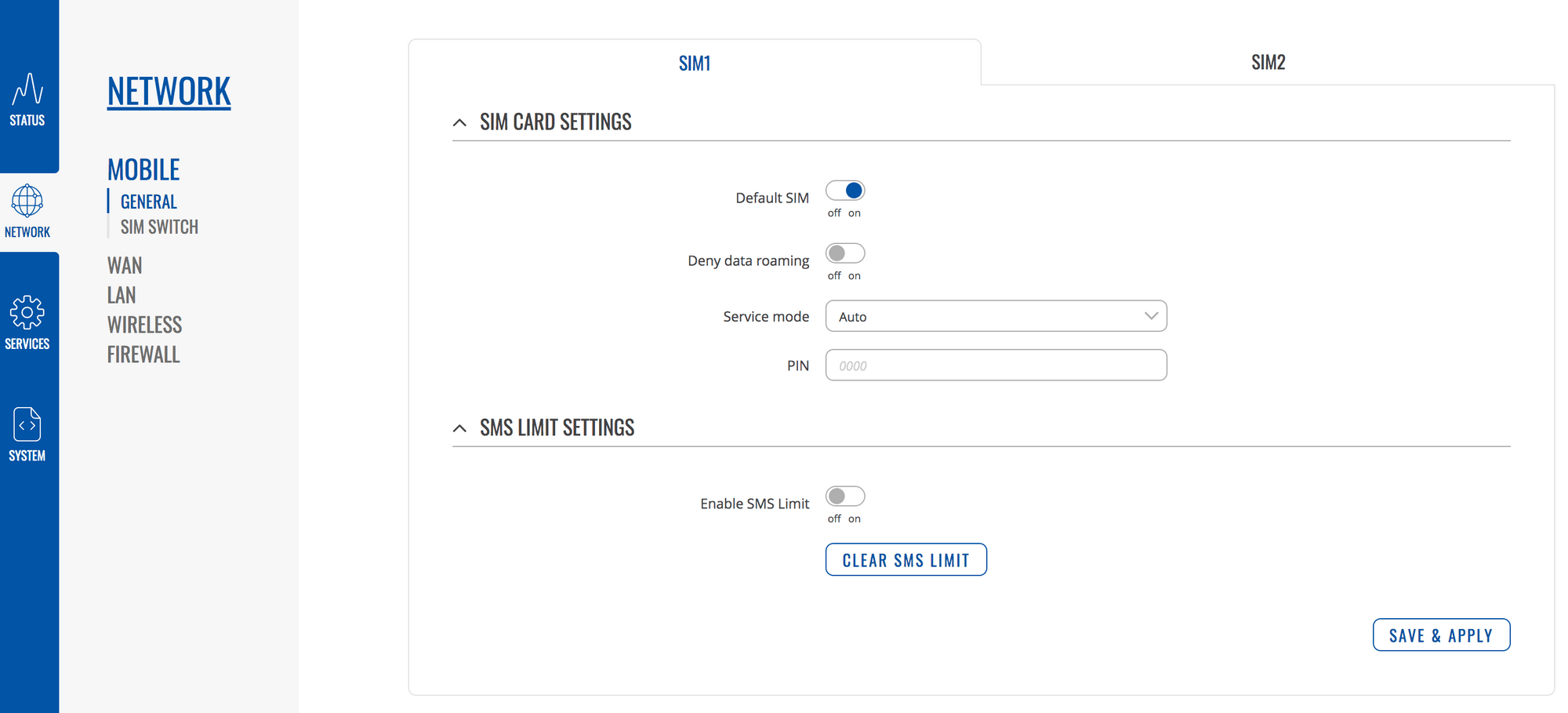
You can control lots of different aspects of the LTE, WAN and WiFi networks. For the LTE side, you can configure the two SIM slots differently depending on the providers, data roaming, etc.
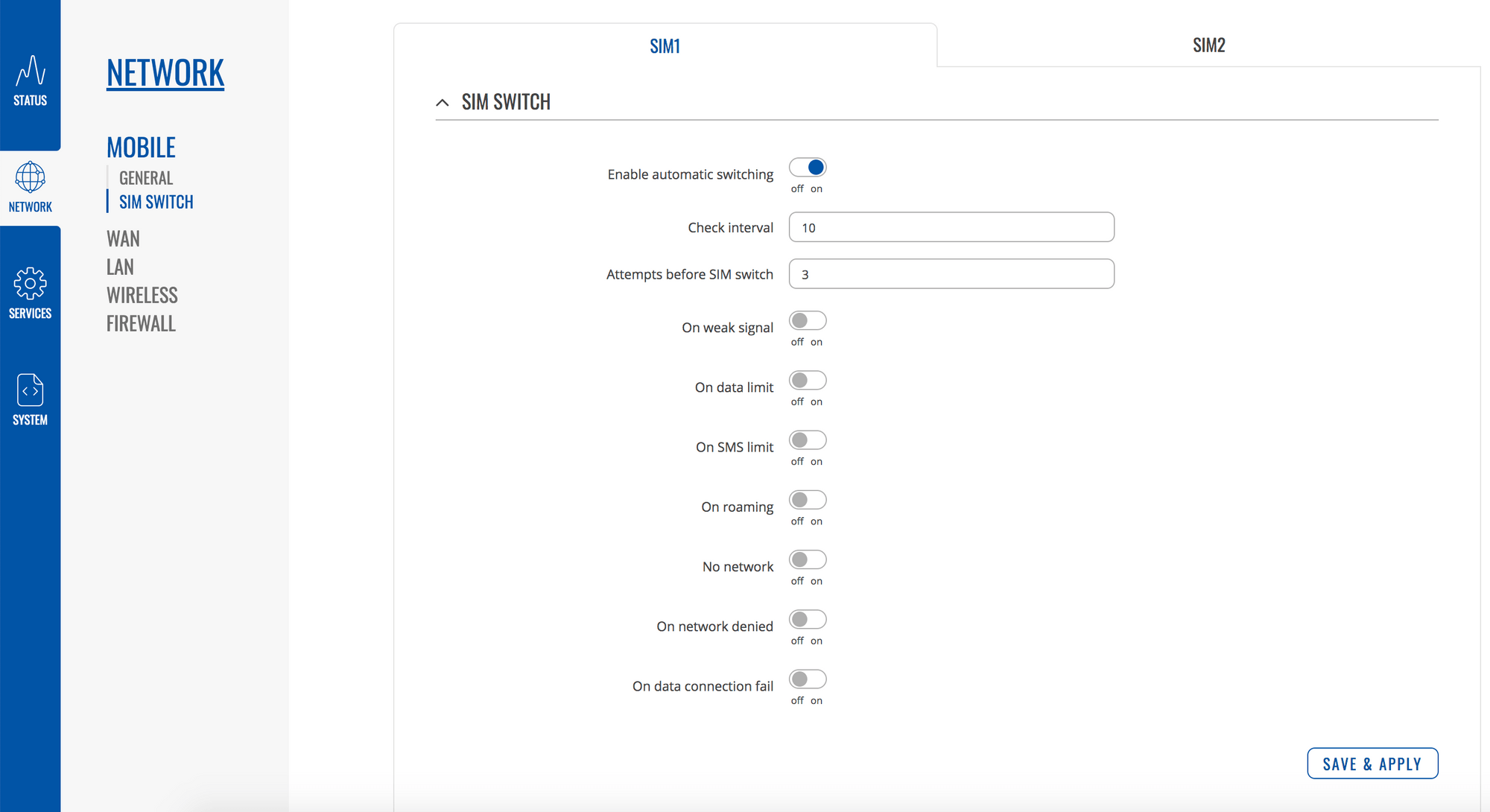
I really, really like the SIM switching settings. These are dials you can adjust to choose when to change from one SIM slot to the other. Not only can you switch when one is disconnected, but on a weak signal, data limits, and even network denials and such. Even Peplink doesn't have some of these choices, although they come close. Even with a single radio, this set of settings alone make it a real viable solution for someone wanting nearly always on LTE connections, as the failover between SIM cards is more easily adjustable.
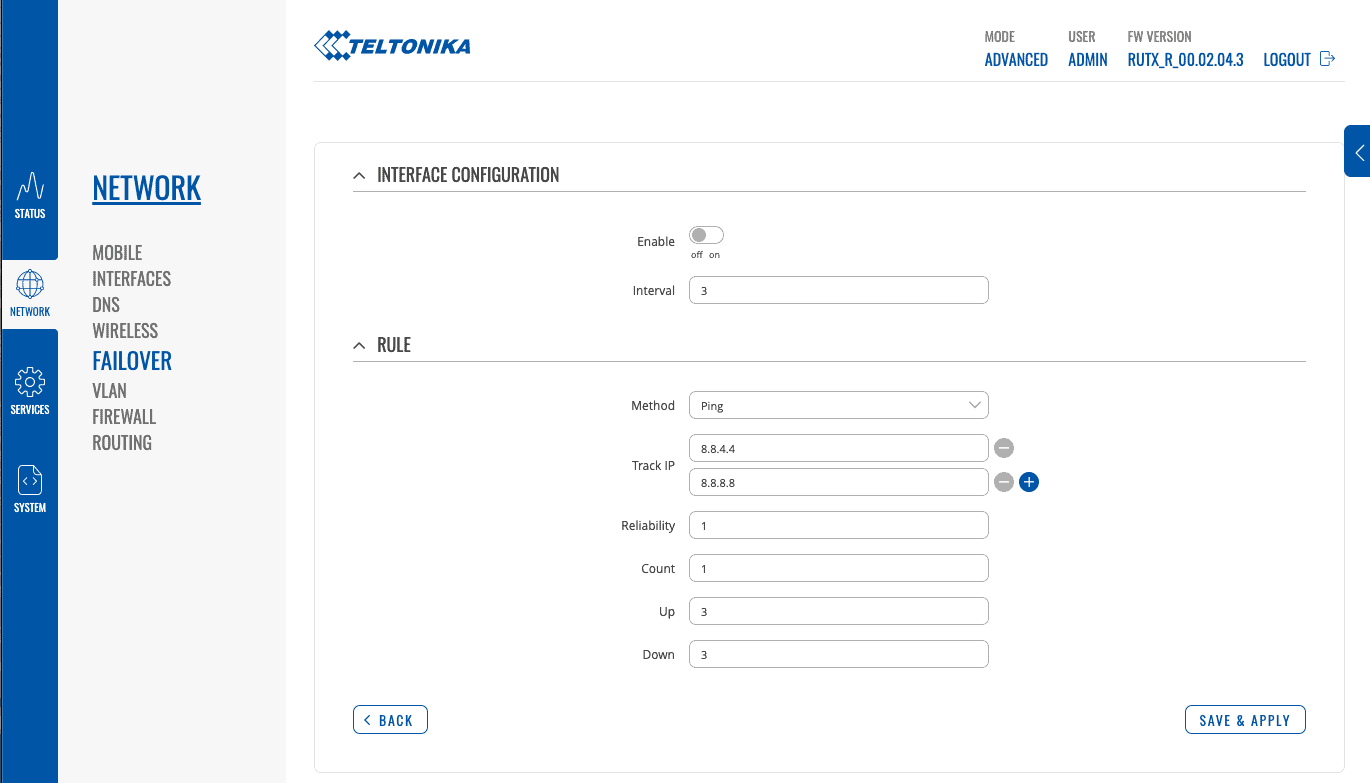
Beyond SIM switching, you can also configure failover on all of the various connections you are using – WAN (wired/WiFi), LTE, etc. The only issue I have with this feature is that it is buried in a Network area, rather than being part of the general configuration, and shown more prominently on the Dashboard. Peplink has gotten this part of their interface right over years of iteration – a clear dashboard with connections, draggable into priorities and failover order. Nevertheless, it is nice to see it here – few routers this size and price have this feature.
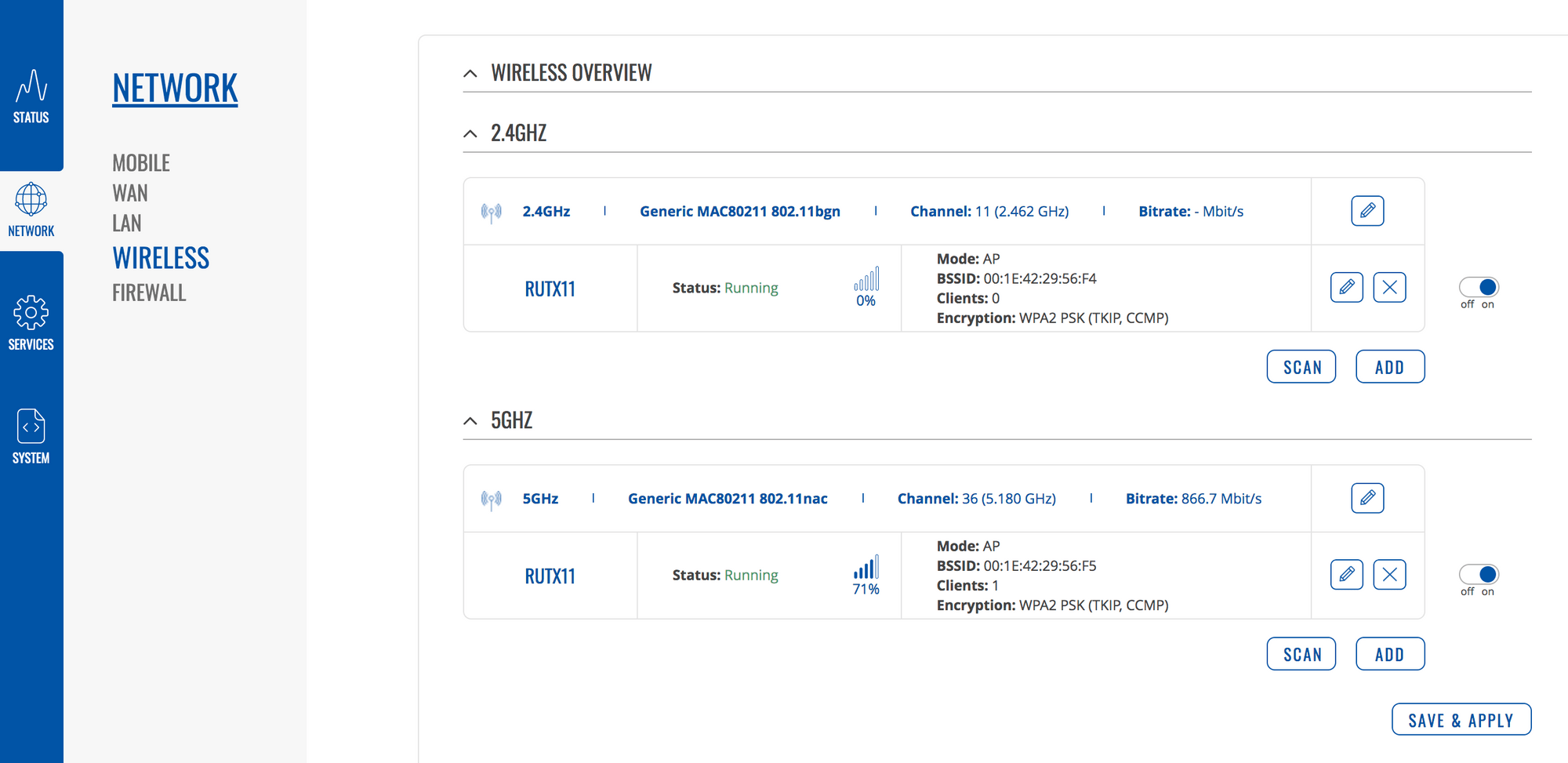
The 2.4Ghz and 5Ghz WiFi radios can be configured independently and have all of the usual settings you would expect in a modern WiFi access point.
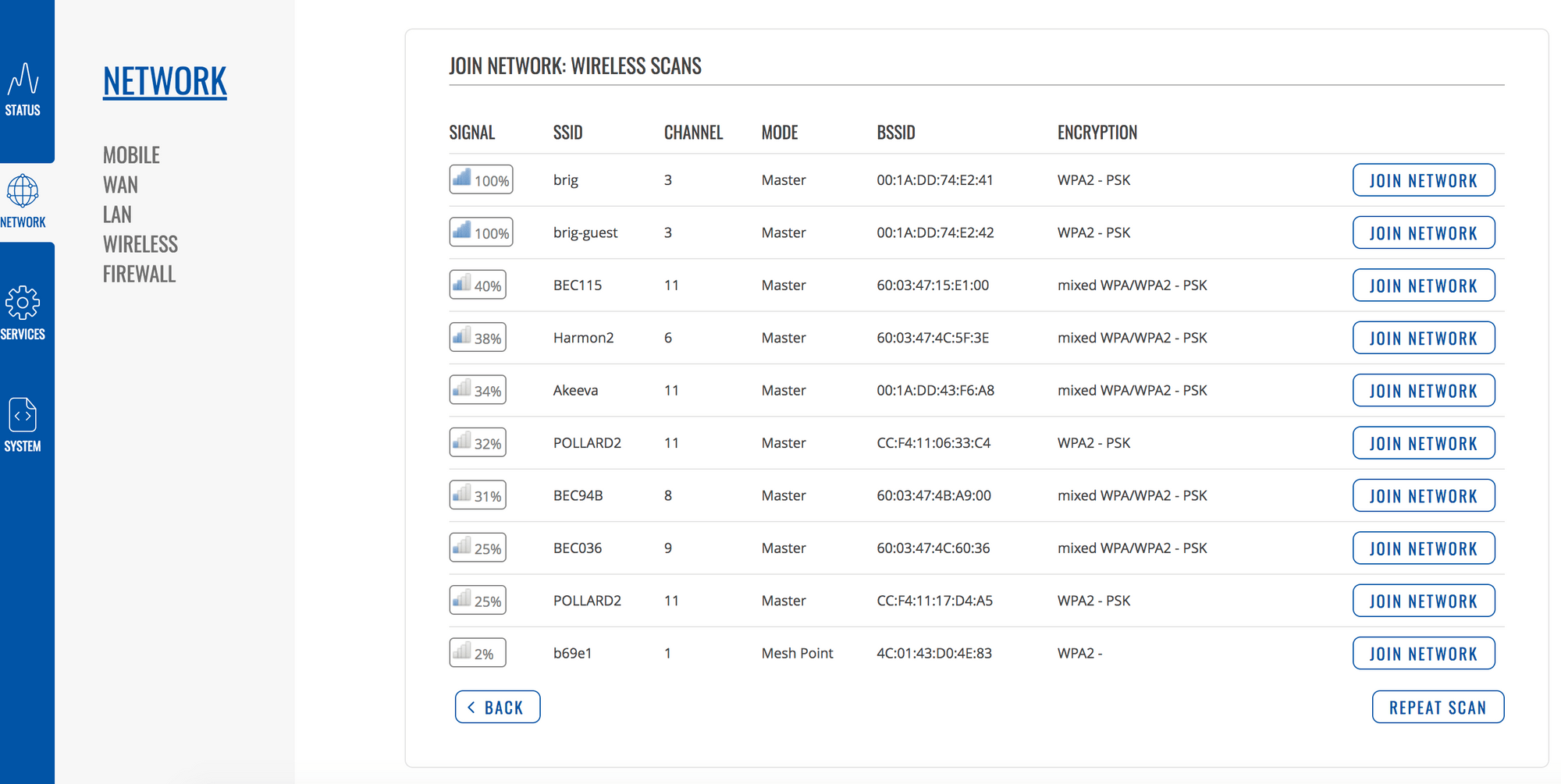
You can also use either of the wireless radios to connect to a remote WiFi network, similar to WiFi as WAN on Peplink products. It's a little more difficult to configure this, and the network interfaces are a bit more confusing, but it is possible to use it this way.
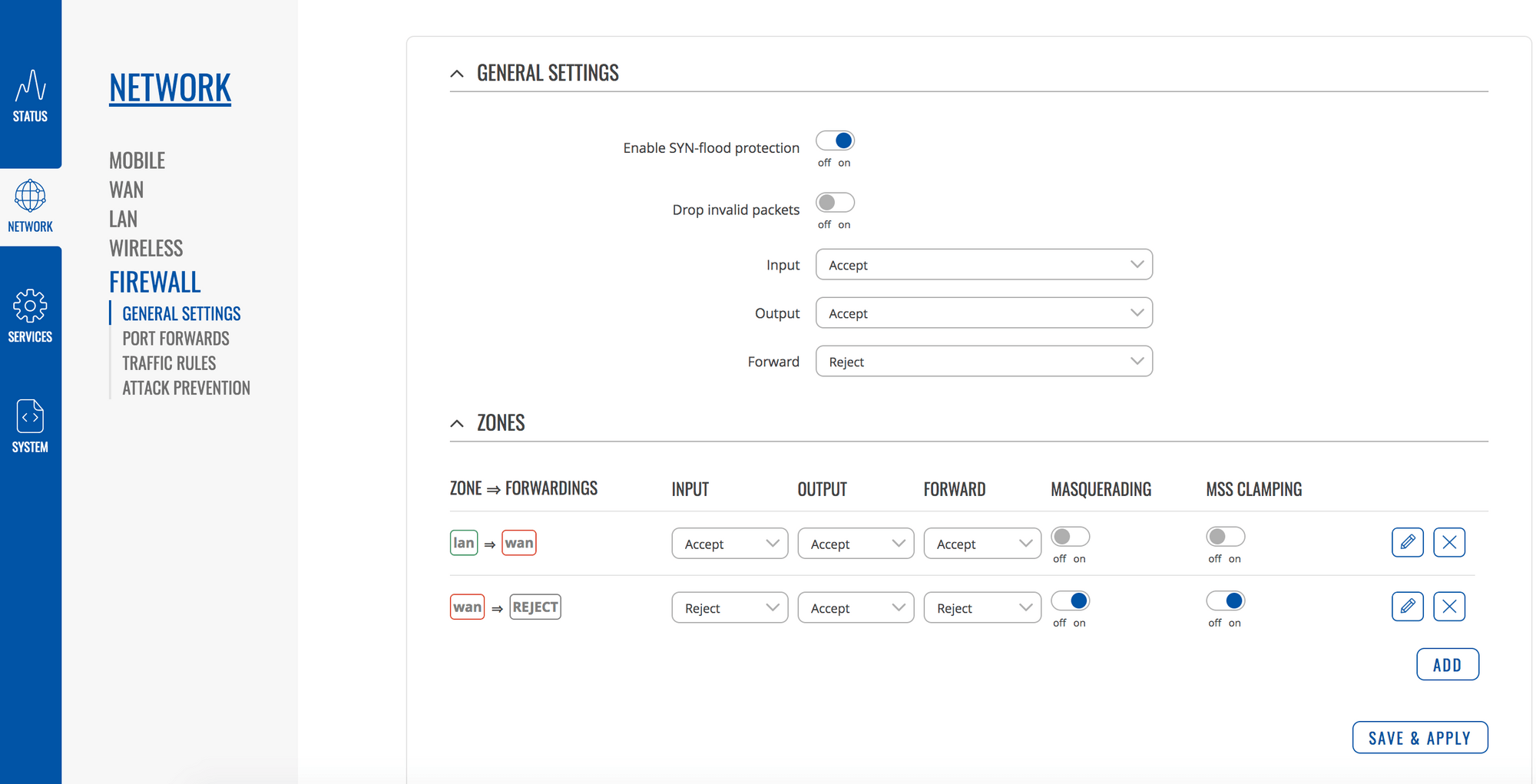
The RUTX11 also has a good firewall included which allows for granular control.
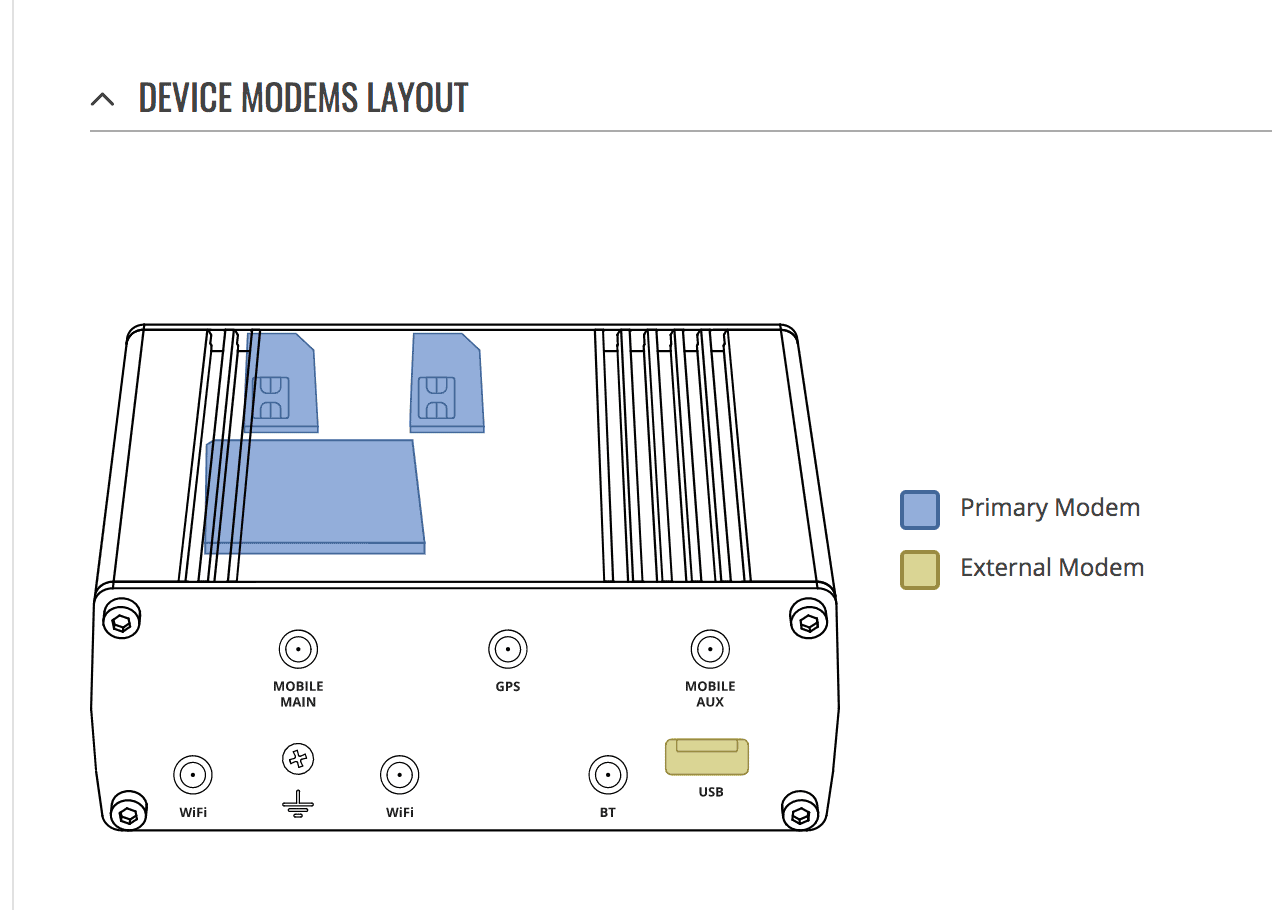
There's even a helpful display showing where the modem and SIM card slots are. I would imagine on a dual radio or more complex product, this could be a bit more useful. You can also connect an external modem or hotspot to the USB port, although I did not have the chance to test this.
Realtime Graphs!
You might know from all of the Grafana dashboards and other things I've done that I love a good graph. Teltonika has some of the best I've ever seen for things like cellular signal, traffic, and more.
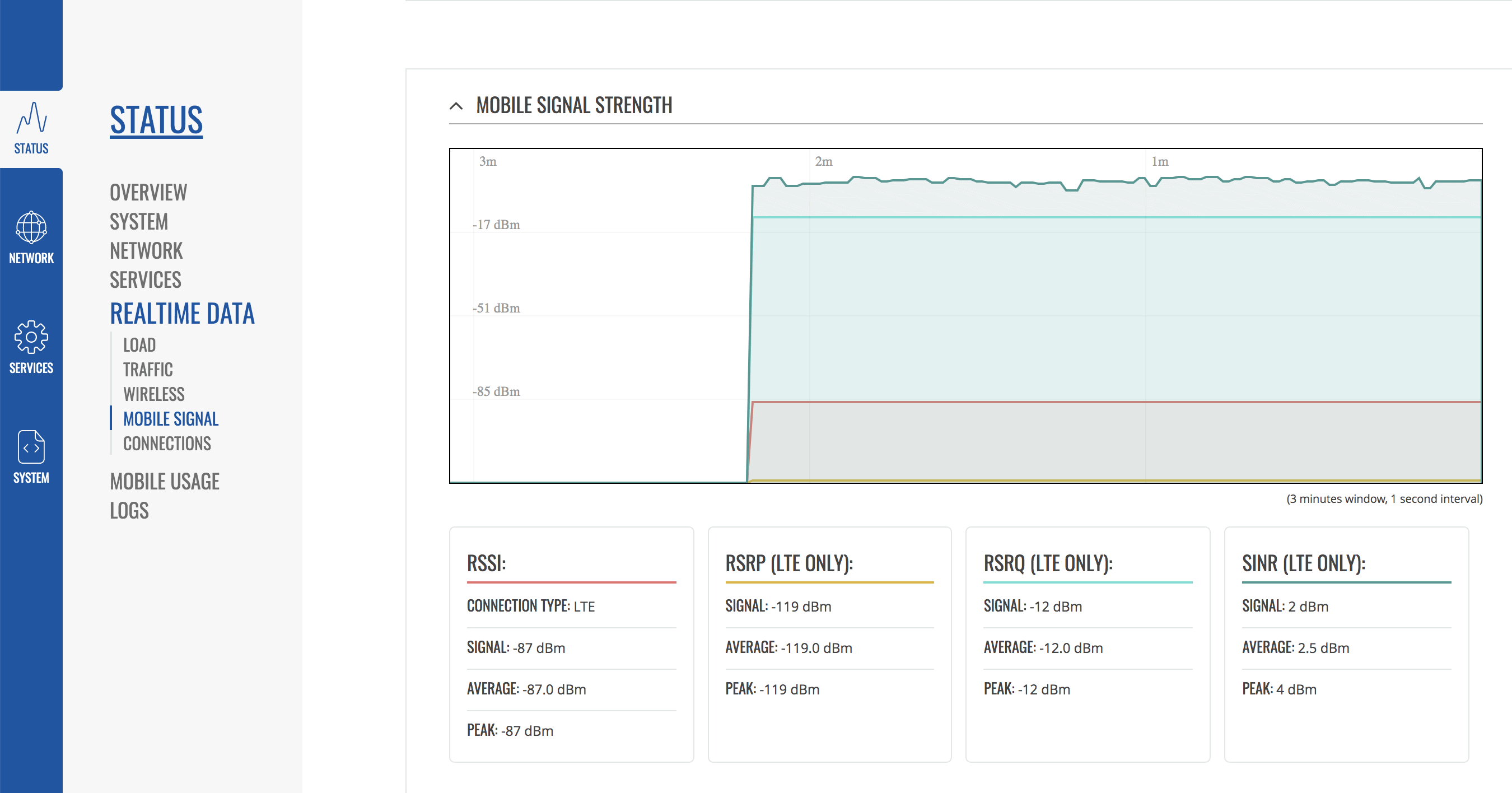
I wish everyone had this graph, because it would make my testing so much easier and more effective. Having real-time graphs of the signal level while you adjust antennas, or swing around at anchor, is super helpful when tuning things or troubleshooting a problem.
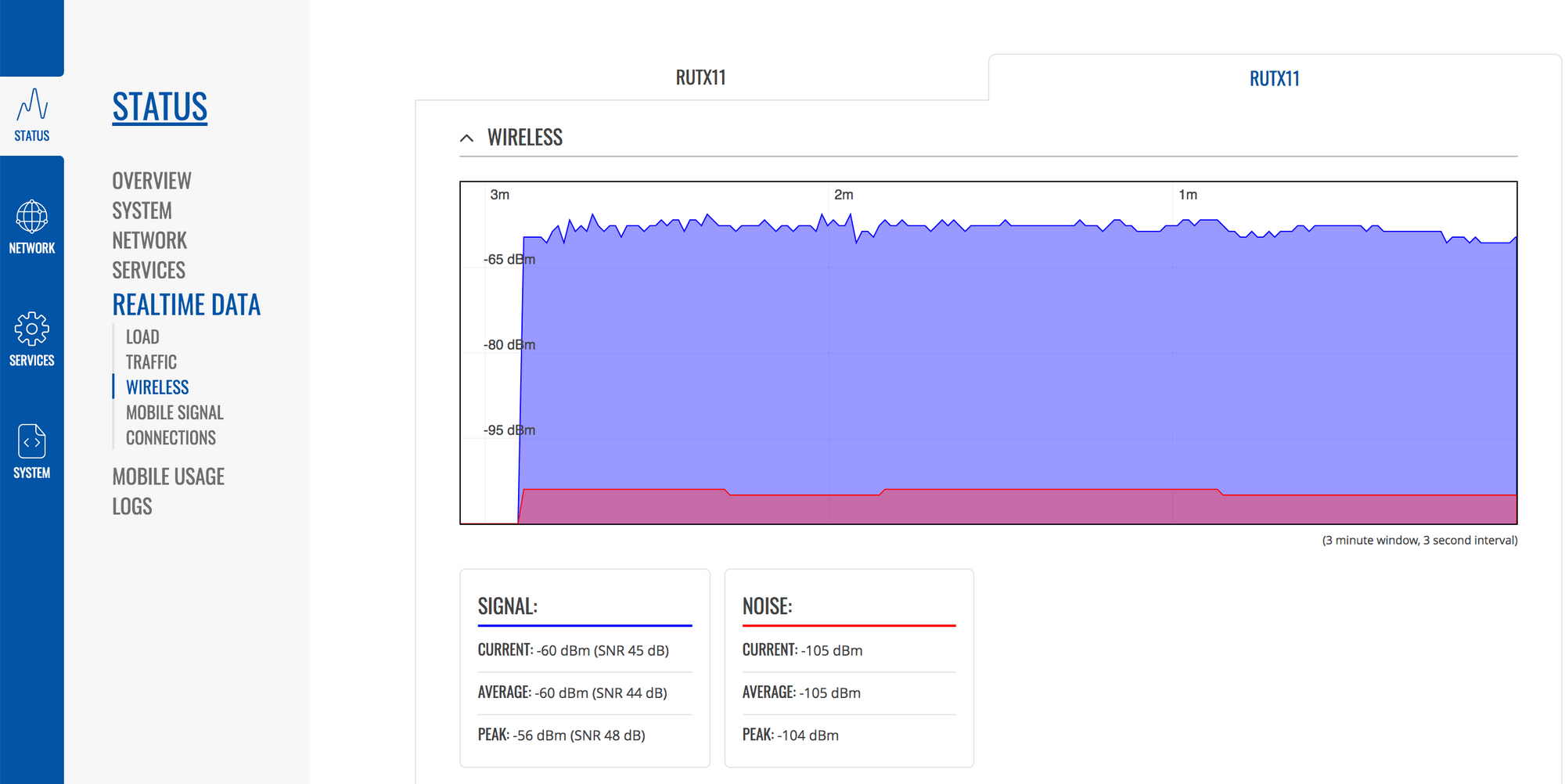
The same real-time graph exists for the wireless side of things, which is also very useful for troubleshooting.
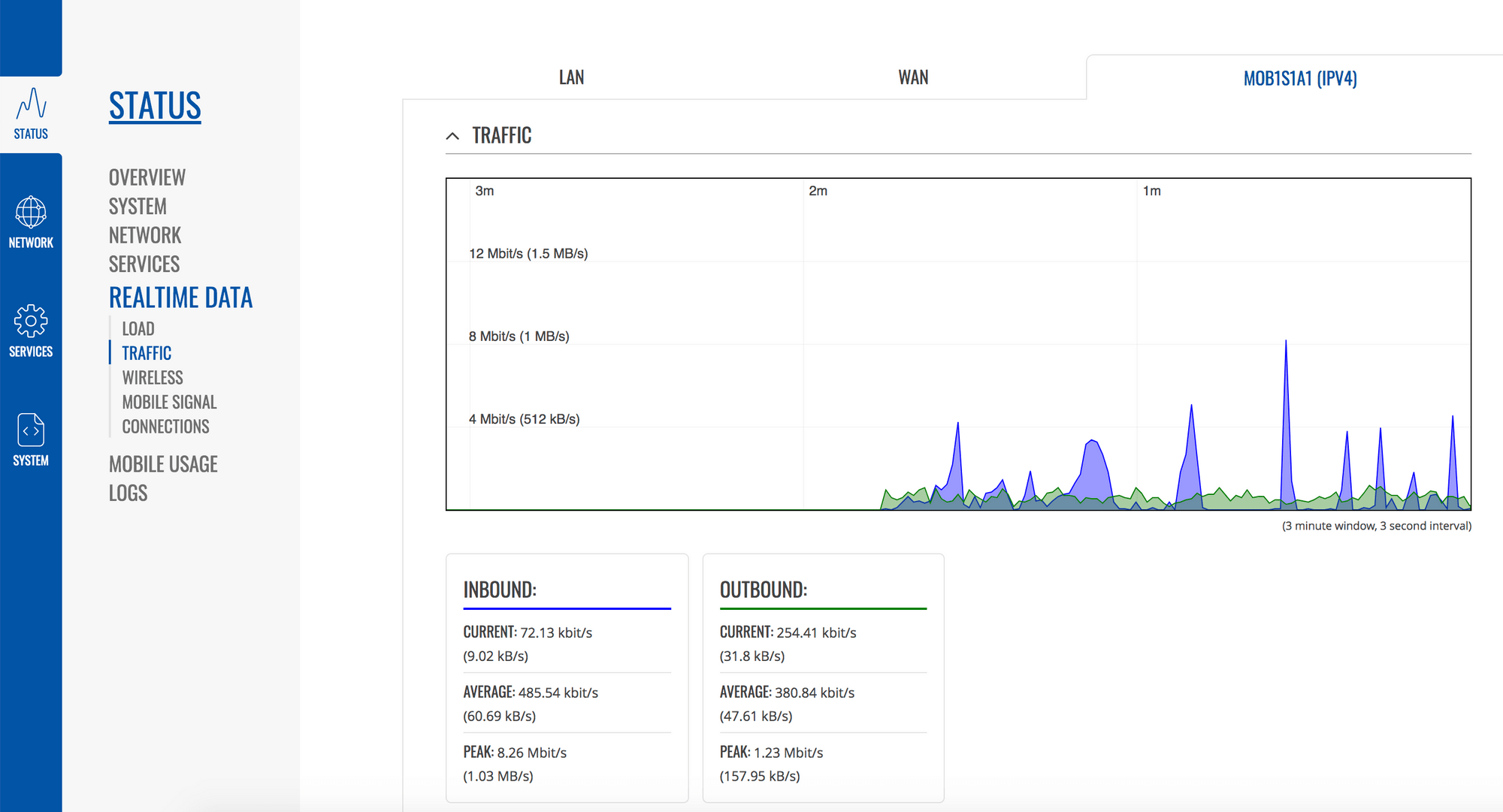
And of course, there is an excellent real-time data graph for LTE. In addition to these, there are graphs for system load and connections through the router.
Services
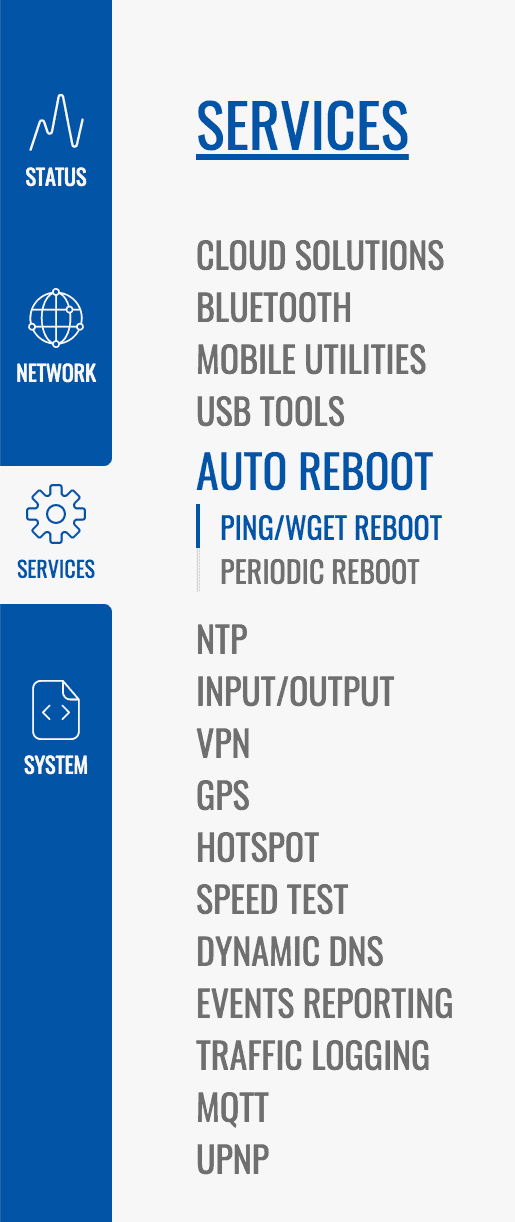
There are a ton of services in this product spanning a wide range of features. If you're interested in a Swiss army knife of features, the RUTX11 has a bunch of them. I'm only going to delve into a few that I found interesting.
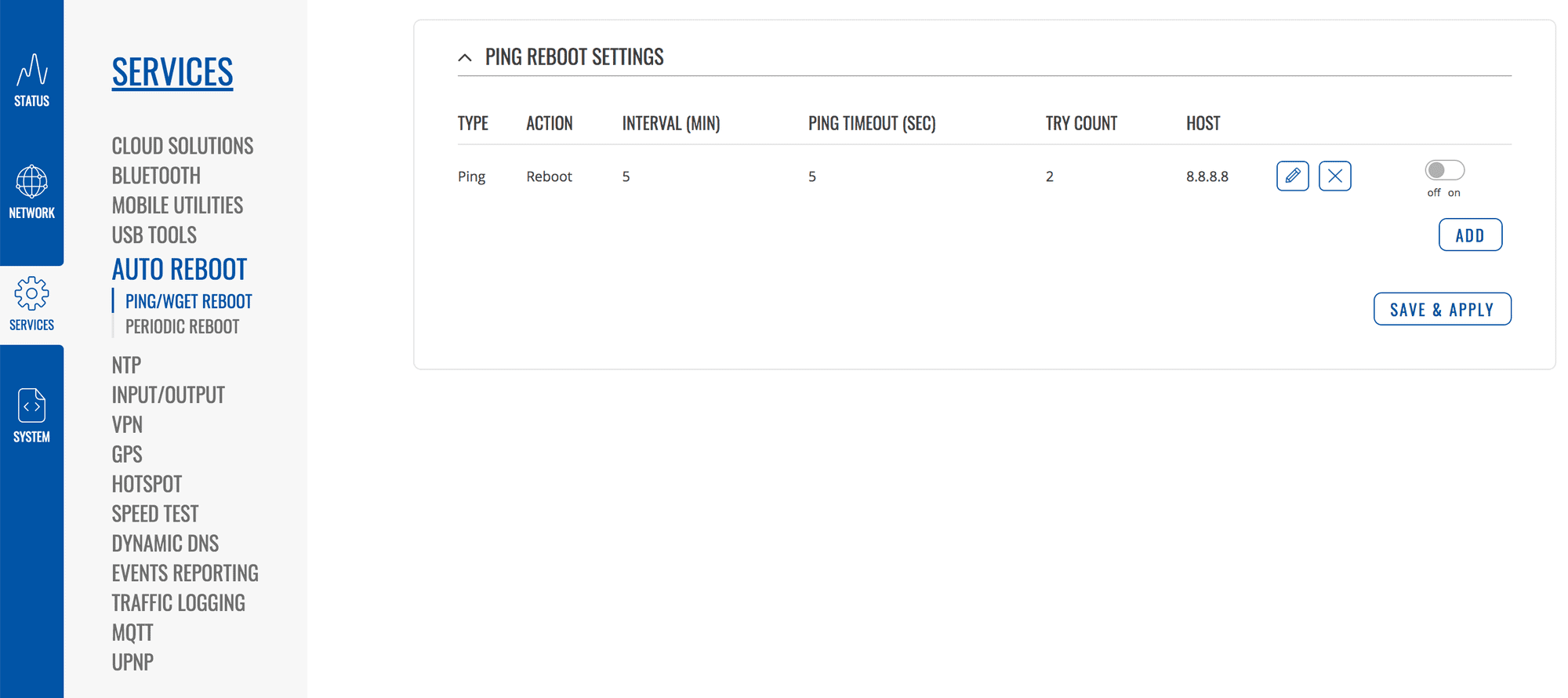
Auto-reboot is a slick little feature that will allow you to check connectivity of something remote using ping, or even wget, which grabs a webpage, and if it fails a certain amount of times, reboot the router. The one I like even more is the periodic or scheduled reboot, which would be good to do once a week or day just because routers will always perform better after a good reboot every so often.
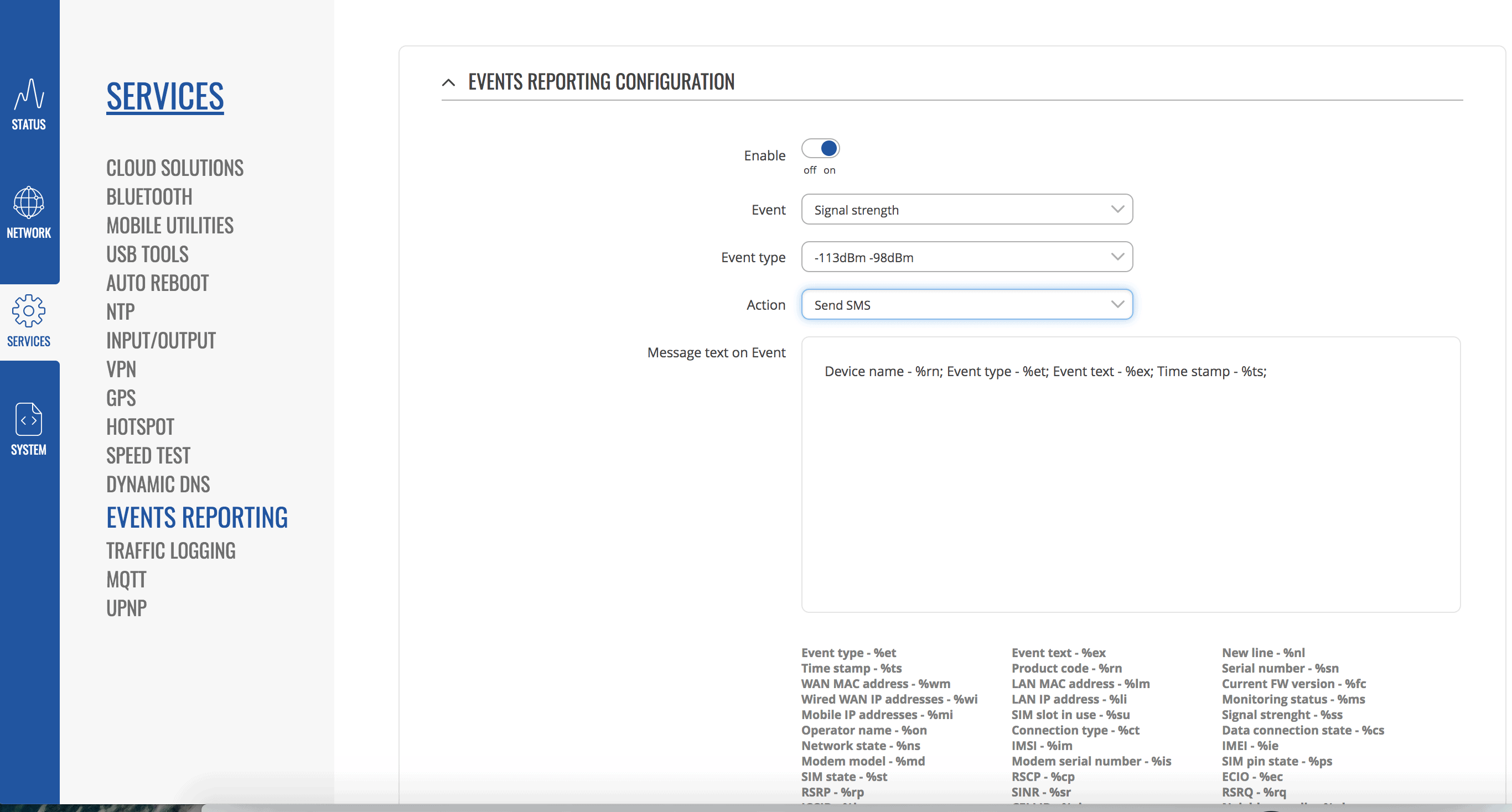
You can send messages for a wide range of events via SMS and other means. There are a bunch of variables you can set, and you can customize the message. This would be very useful to be notified if your LTE connection is unreliable, WAN goes down, and other scenarios when away from the boat, especially if you rely on the system for remote monitoring.
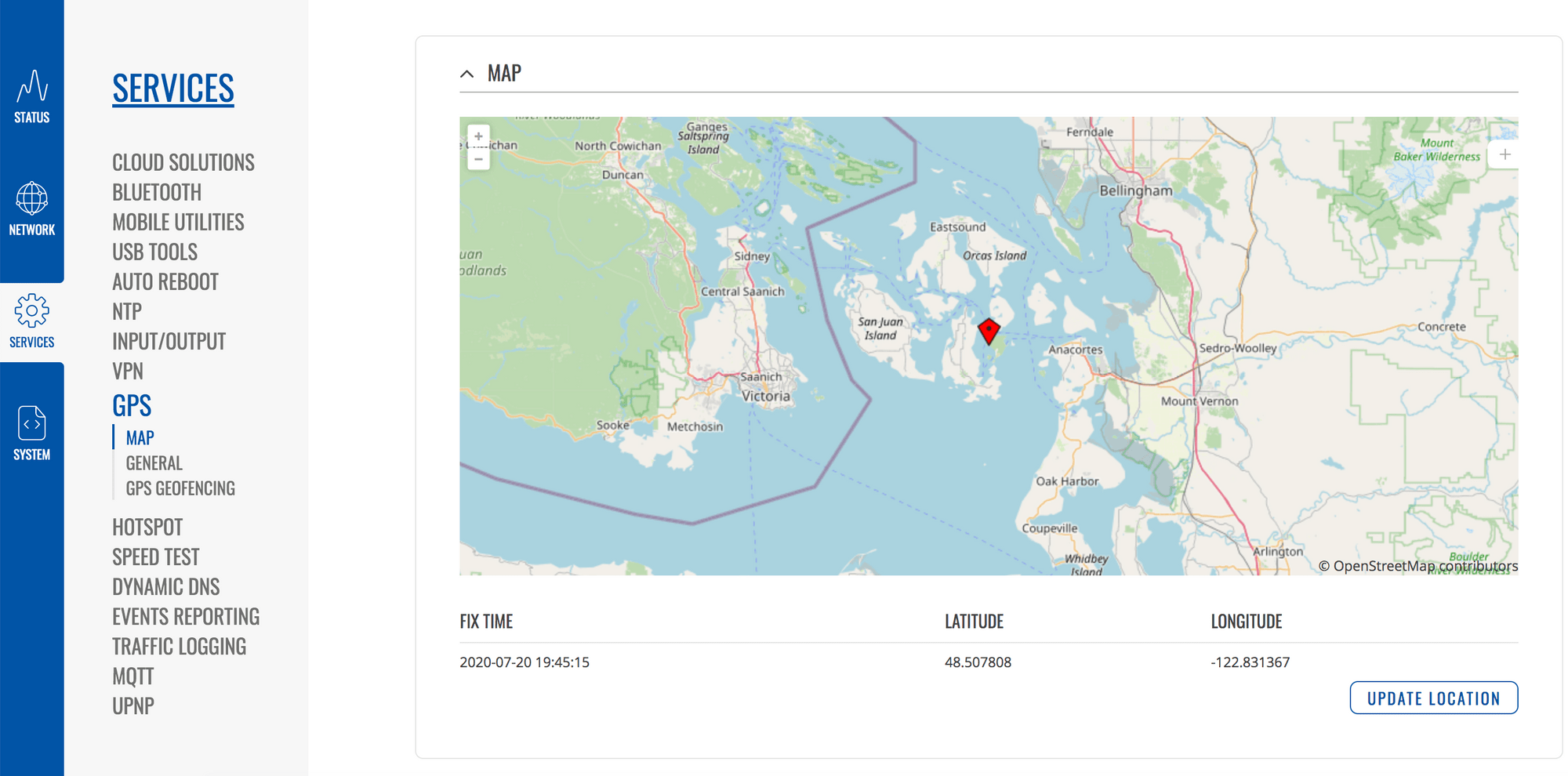
The RUTX11 has a really good GPS tool set that allows you to setup various aspects, and it can spit out GPS data on the local network so other devices can consume it. You can see even more details in the GPS documentation online.
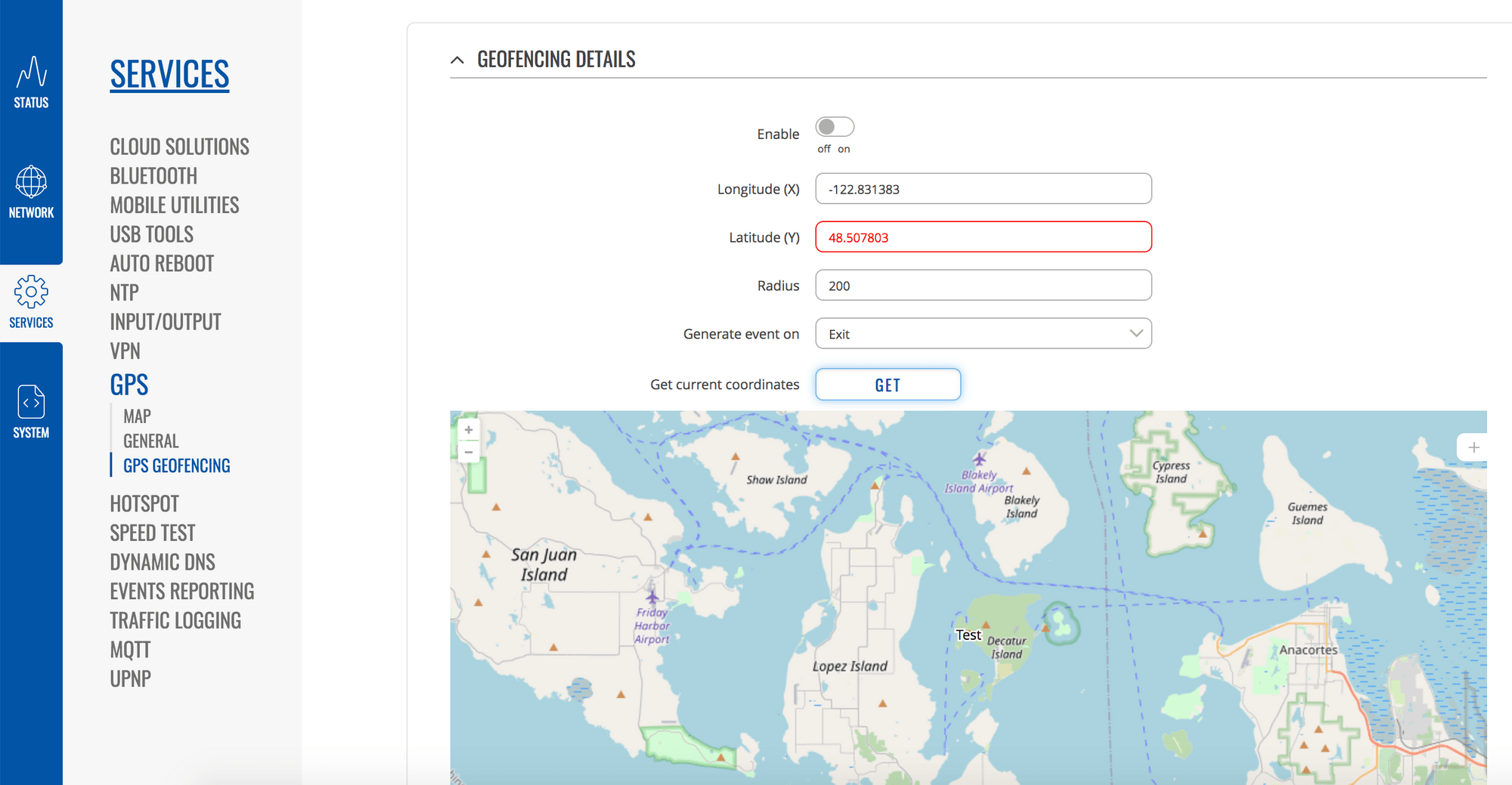
There's even a setup for geofencing, which would allow you to set a particular GPS point and radius, and then get alerts if your boat moved out of that circle.
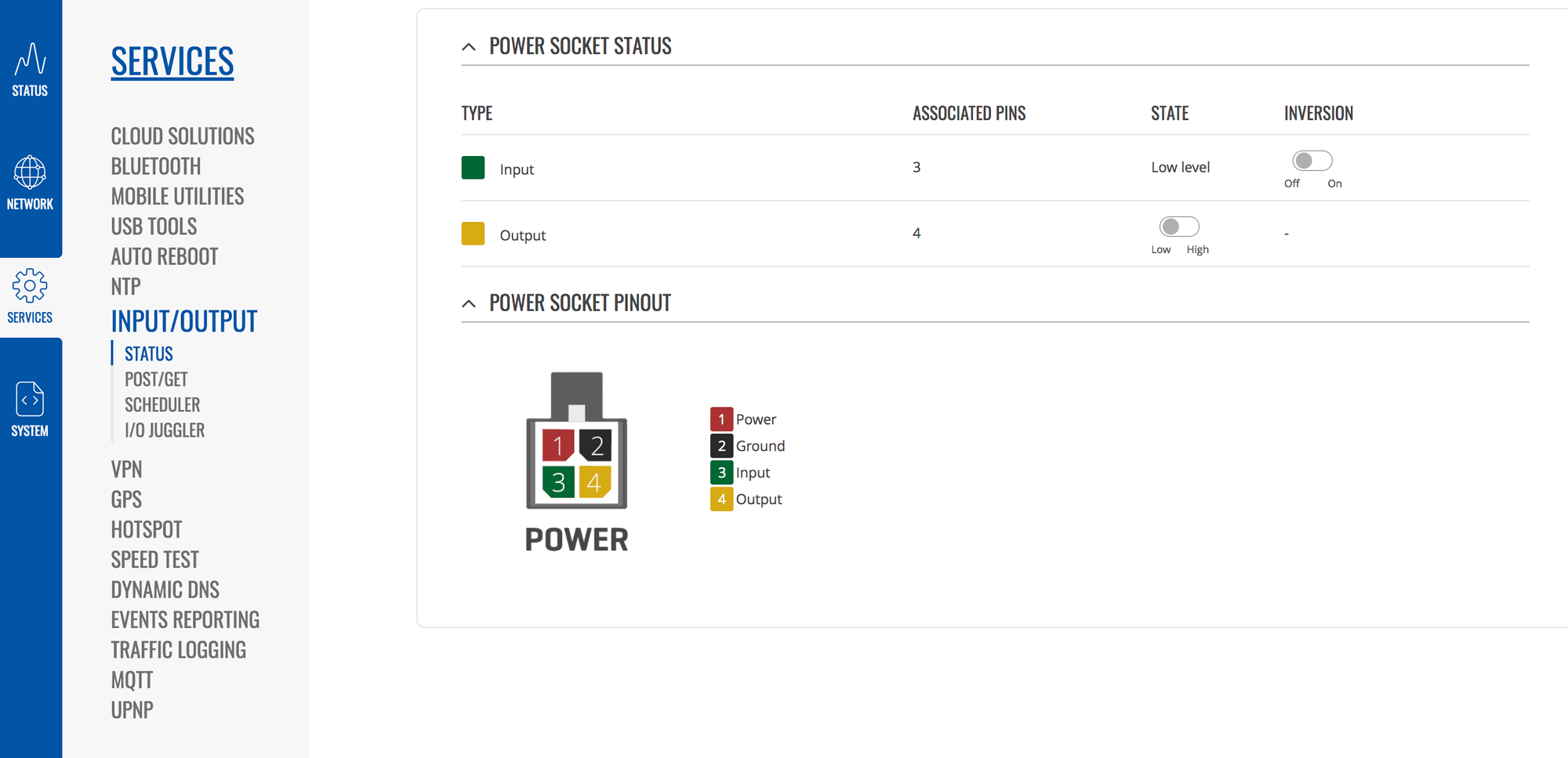
The power connector also has an input and output connection on it so you could monitor an external system, or trigger something outside as well. This could be used to watch for a bilge pump turning on, or trigger an alarm horn in the case of an alert. You can even build a schedule to turn on/off things based on the time of day, day of week, and more. Again, every little detail is covered in their excellent online documentation, and you can even nerd out with using curl to control the whole product remotely or through automation if you want.
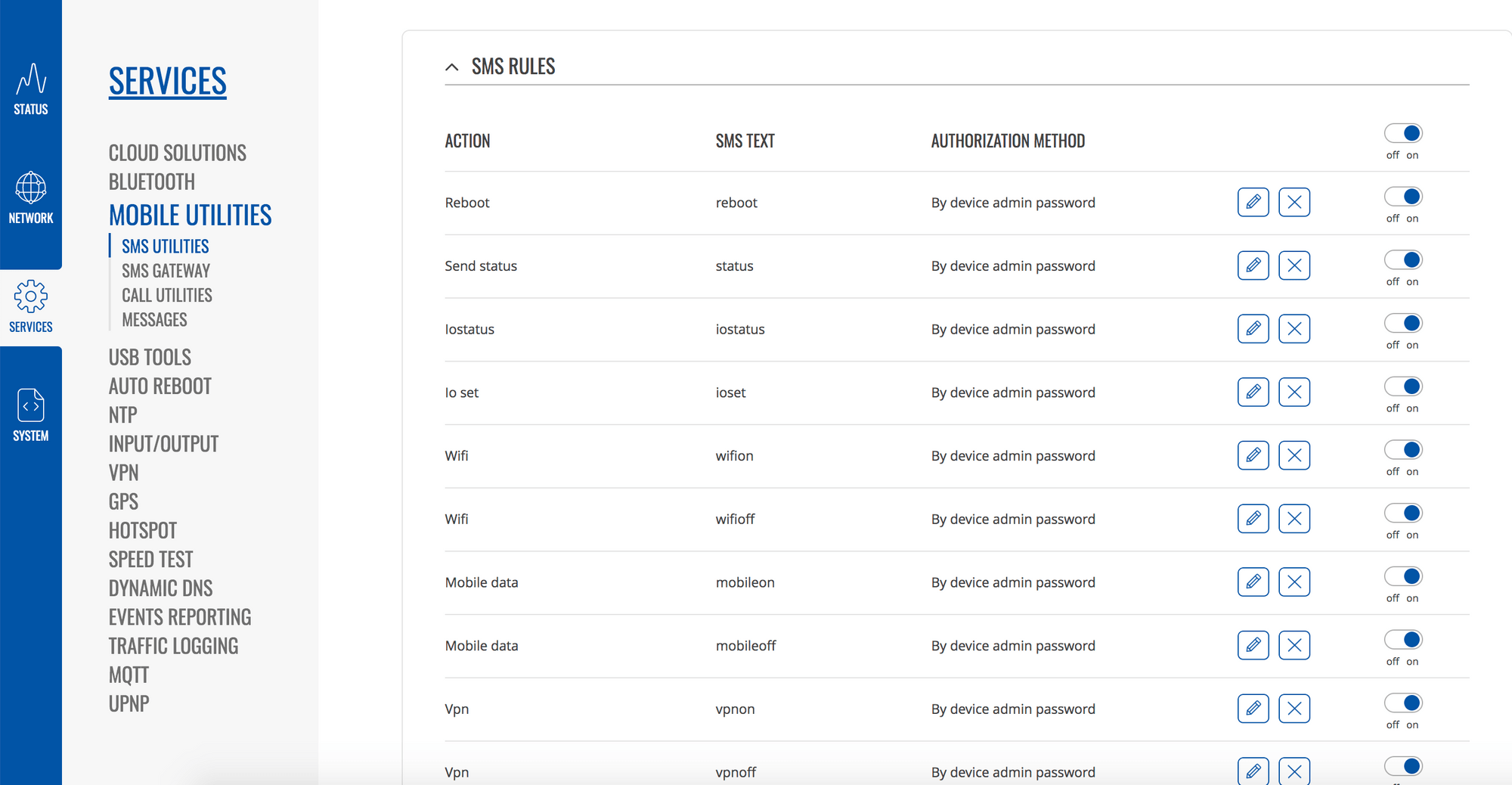
There's even an SMS / text message set of tools. The most interesting one is the ability for you to send pre-formatted text messages to the router and get status as well as control the router remotely. This could be useful when away from the boat and wanting to check on the amount of data your LTE connection has used, or if things are wonky, to send a reboot message to the router. There are some security pieces in place to protect an average person from taking advantage of this, but it does have some risk.
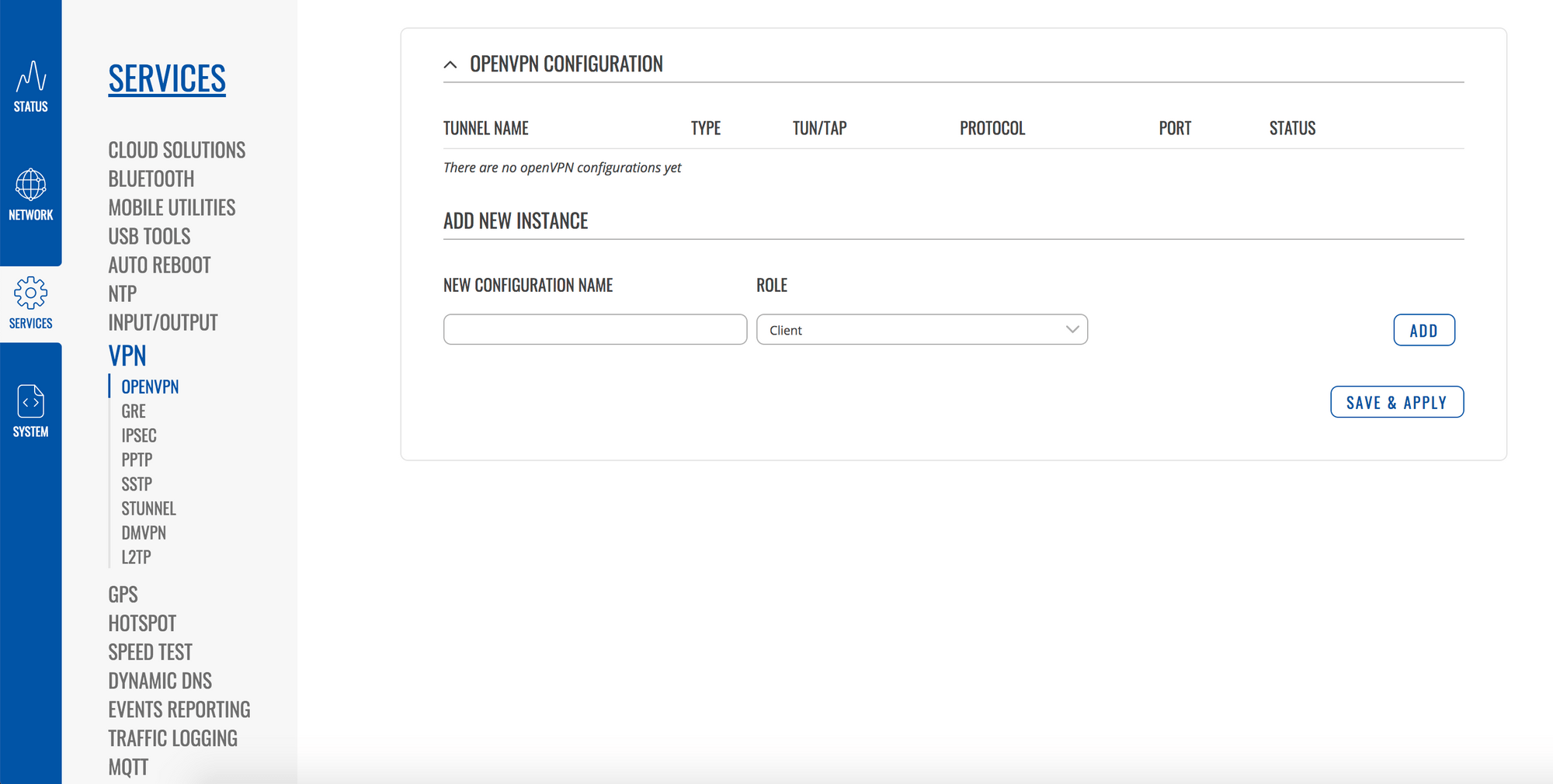
Last, and definitely not least, there is a full fledged set of VPN servers on this router – from OpenVPN (my favorite) to DMVPN, you can setup a ton of different options and pieces from the interface. I'm sure there's even more details you can do via the command line. This would really allow a lot of flexibility in being able to have your router connected to a VPN at home or in the cloud so you can remotely connect into the boat securely to check on things.
System
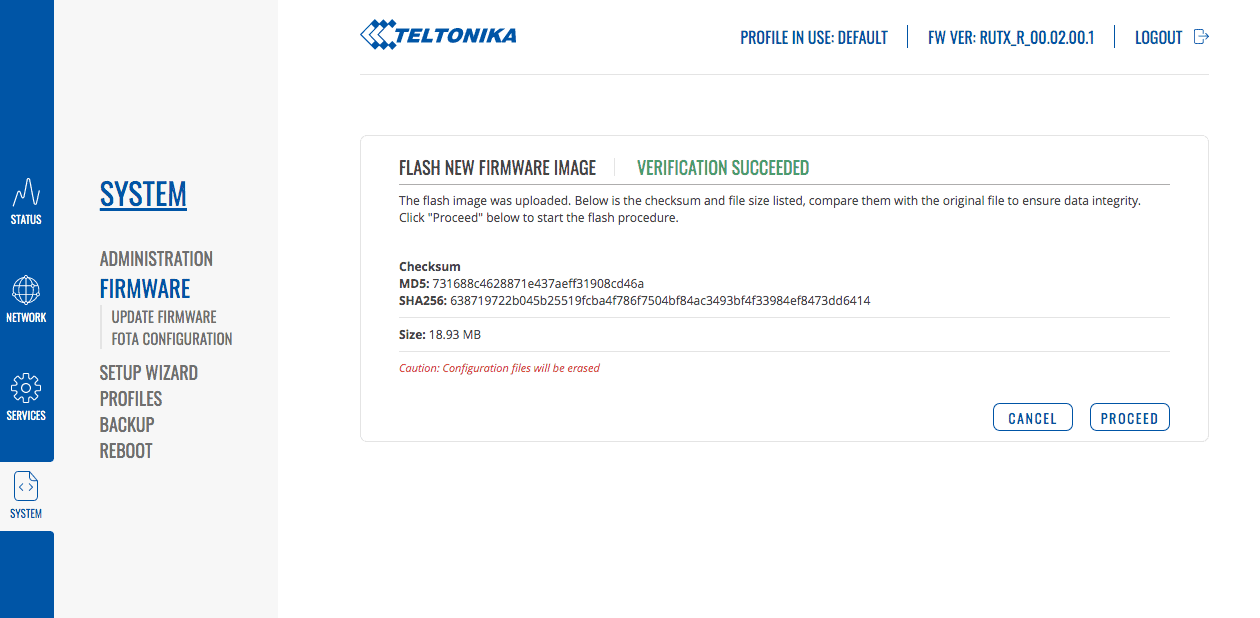
There are a bunch of bits in System as well that are useful. Teltonika have an online software server to deliver firmware, and use a good signing process to protect updates.
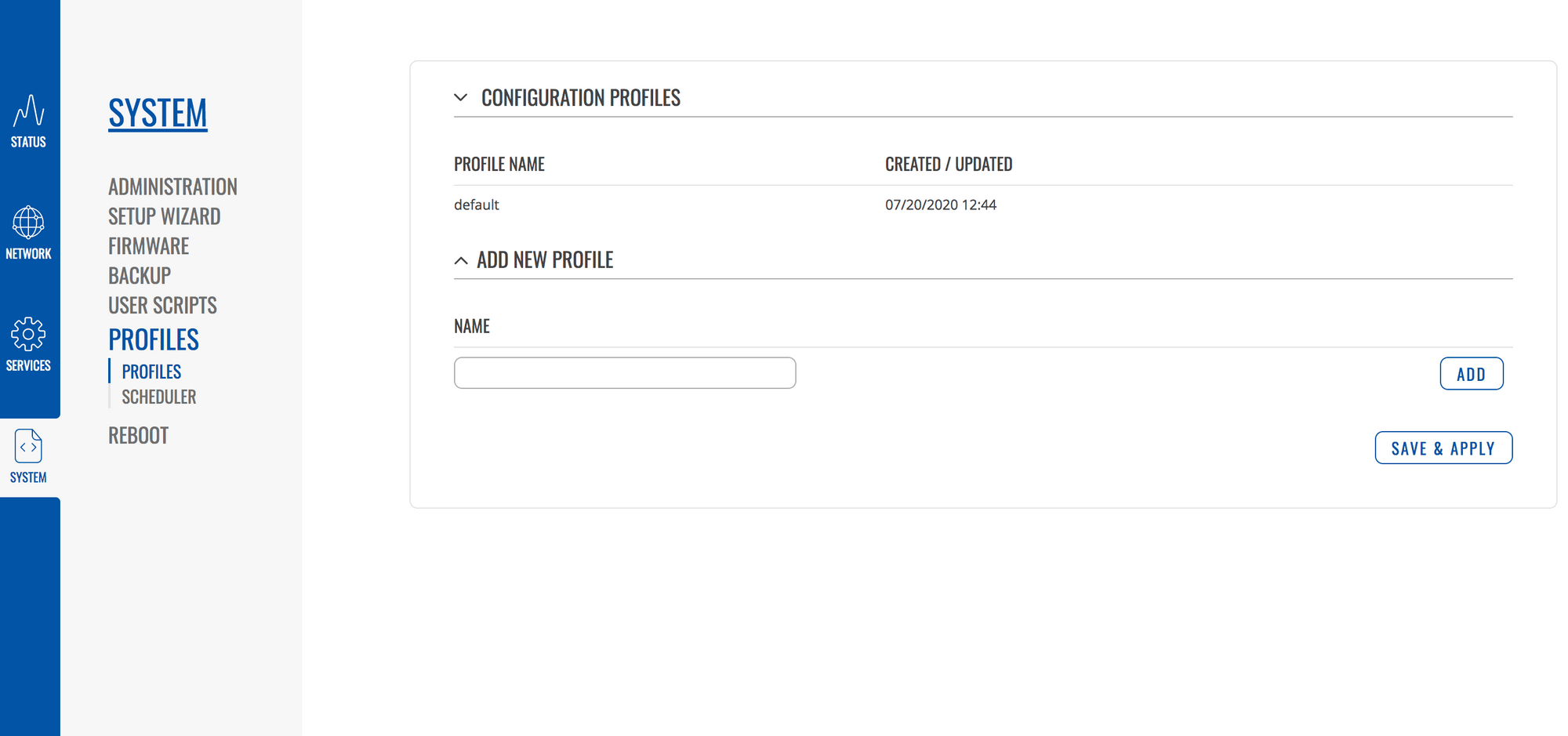
In addition to the rest of the usual features like admin passwords, upgrades, backups and such, there is a feature that allows you to save the current running configuration into a profile, and switch between them quickly. A very nice feature.
Beyond this huge list of software features there are even more that I didn't cover. In addition, if you are a command line person like me, you can flip into the OpenWRT command line via SSH and other means and configure everything that way, plus even more options.
For the price and size, this router has a ton of features and configuration possibilities. I'd say it has more features and services than Peplink and Cradlepoint for sure, and that could make it attractive for folks looking for those particular features or automation. It does struggle a bit in some of the basics, inasmuch as it makes them a bit more difficult to configure.
Remote Management System
Teltonika have a Remote Management System (RMS) that you can use to manage and monitor your router(s) with. A decent amount of the features are free, and some require credits and payment for more advanced items.
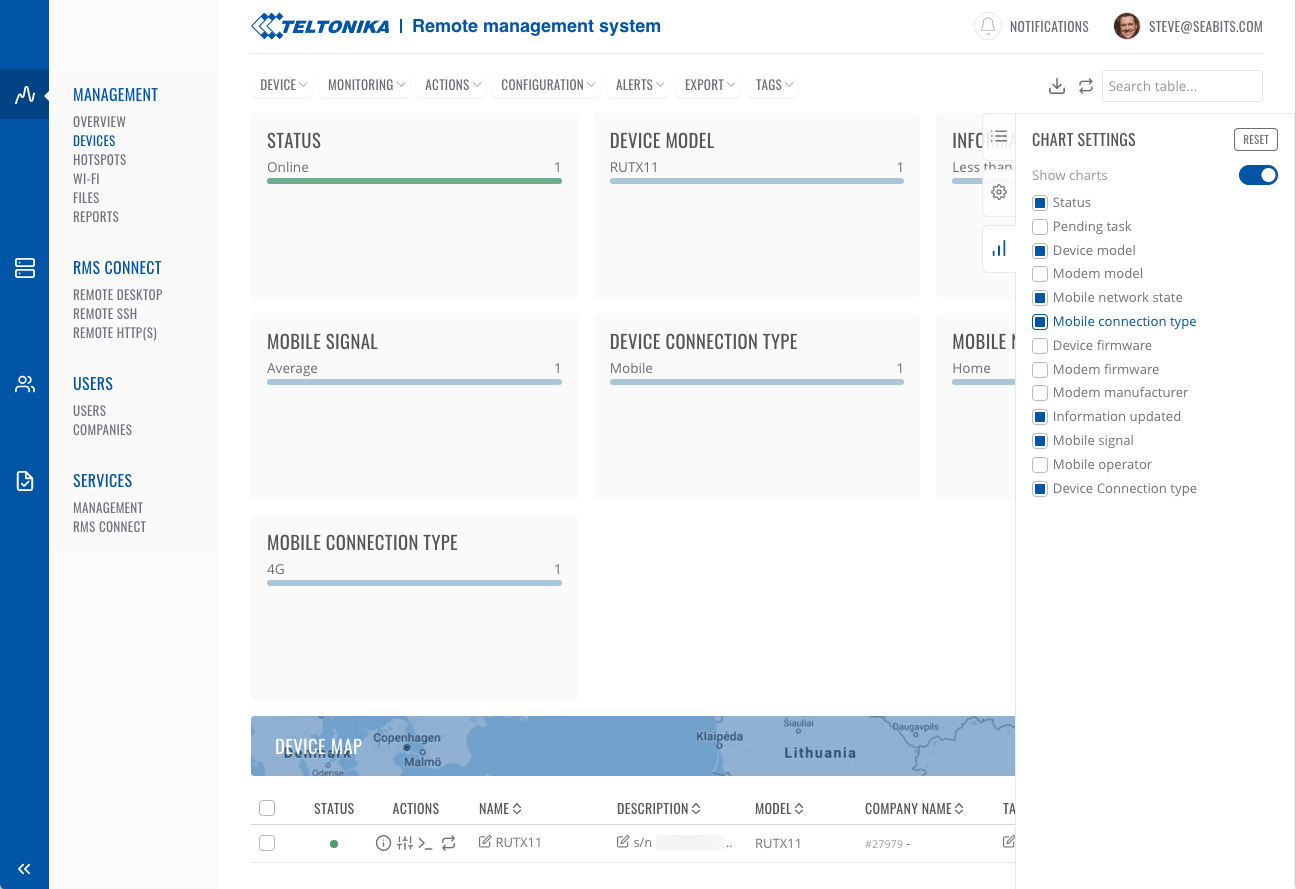
The system requires you configure your router to connect to the RMS, which means that it will be sending data to their servers. They do protect it from other people seeing it, but you should consider whether you trust a particular company to have this level of access to your router. There are features that allow you to connect back to your router, and to devices inside your network if you set it up. However, it is useful to manage things remotely when you are not on the boat.
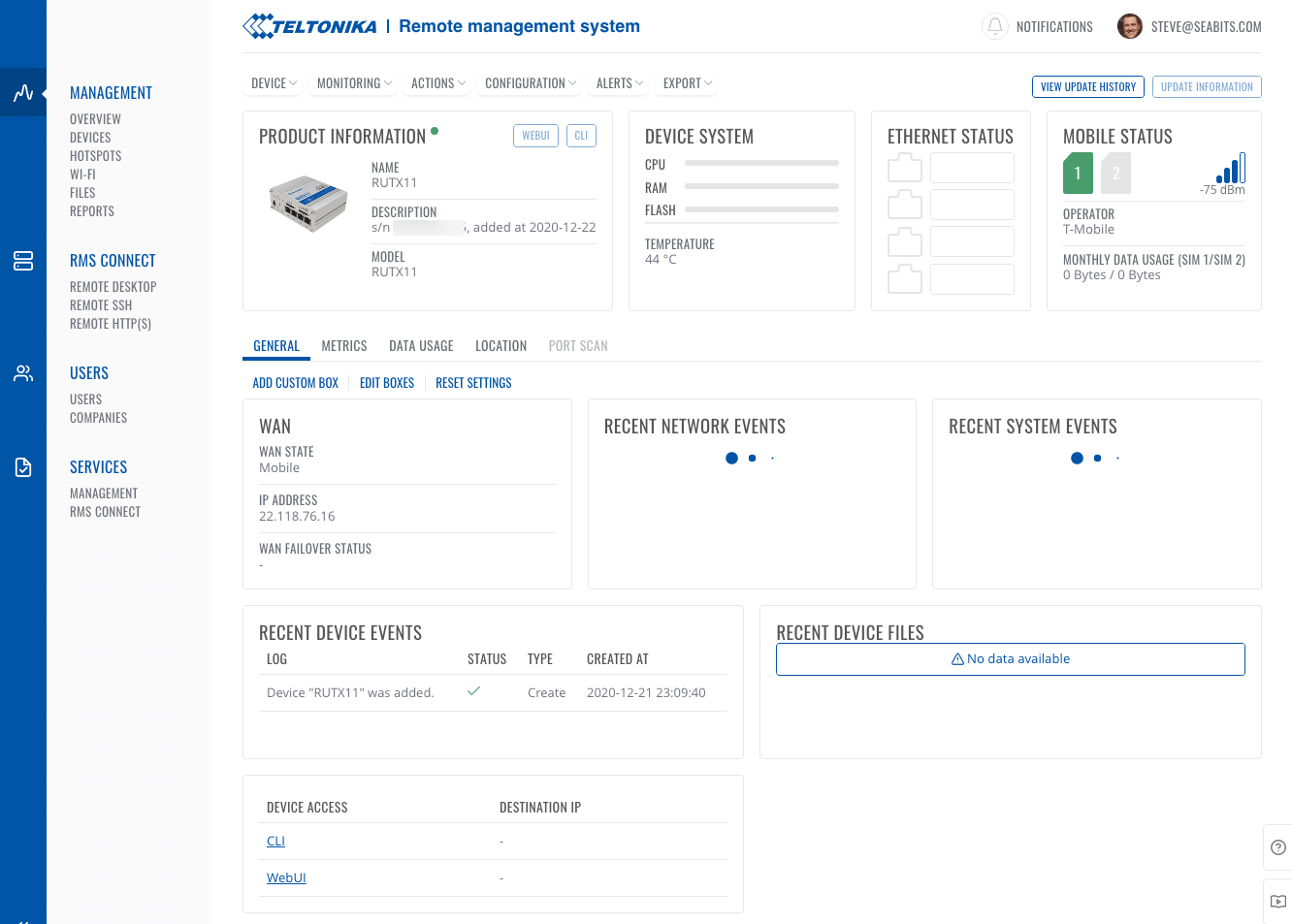
You can delve into an individual device and see relatively frequent updates on connectivity, IP addresses, which WAN device is being used, and more.
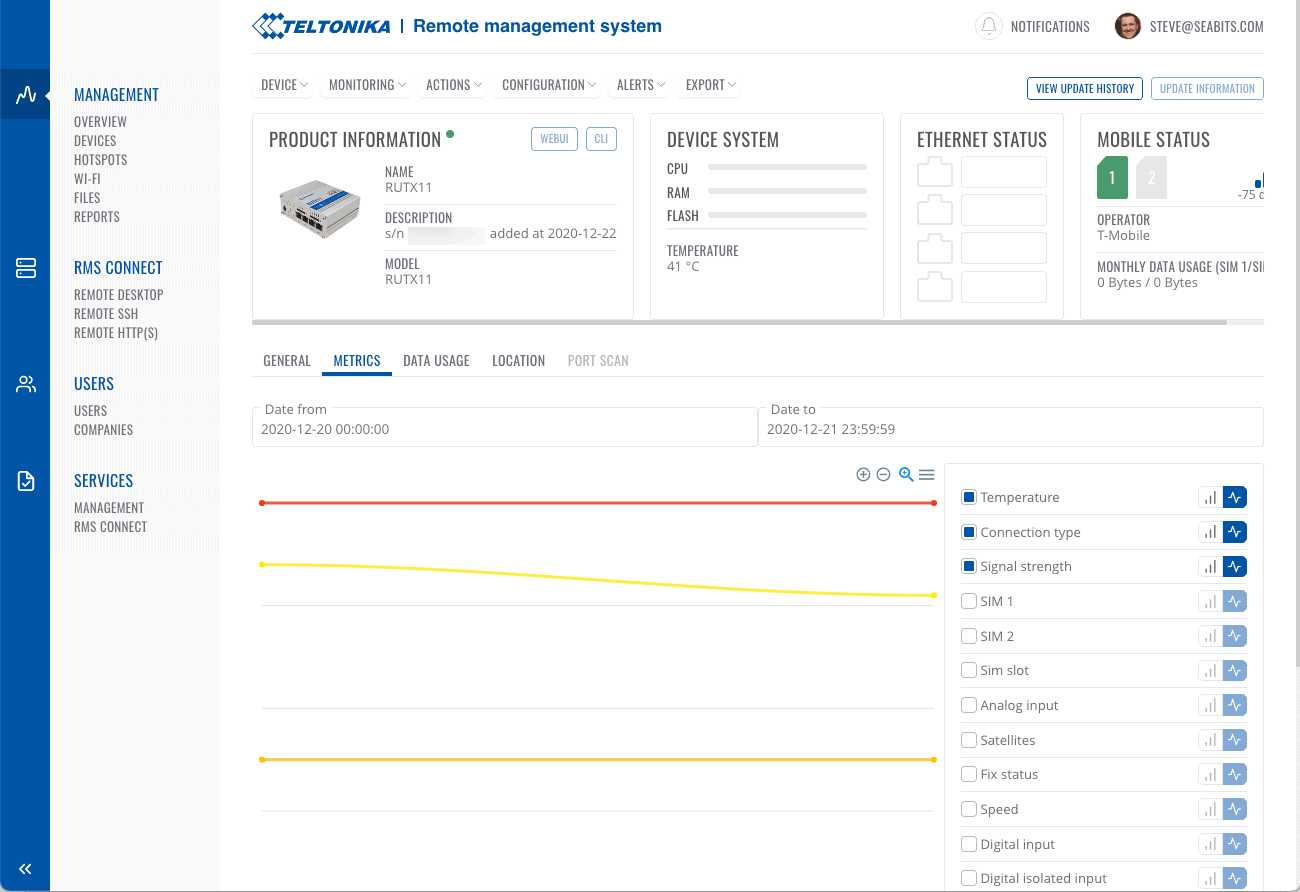
You can also look at longer term metrics and configure different graph items.
Beyond the device screens, you can use the RMS product to set global WiFi and hotspot settings and push those out to multiple routers, sync files to groups of routers, and much more. There's even RMS Connect which will allow you to connect to machines on your local network, if you're so inclined.
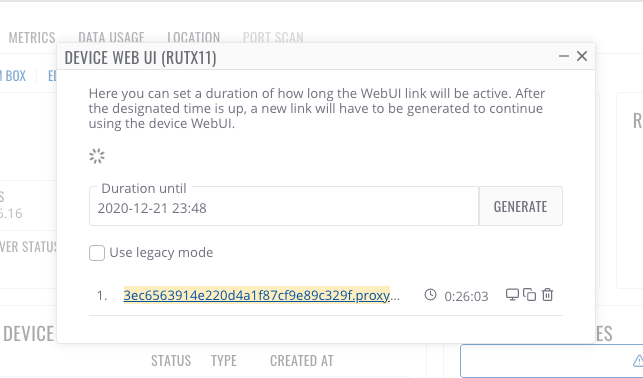
One of the most useful features of the RMS is the ability to connect remotely to your router. This is handy in case you need to check on connectivity or make a change without being on board. Teltonika uses an OK method of doing this, by generating a URL that you can have expire by a certain time, and then proxies that to the router through the connection it has to the RMS. You still need to login using your username and password.
The RMS is a useful tool to keep an eye on things if you need that. If you have multiple Teltonika products, I could see how managing them would be easier this way. For security purposes, it might be easier to use a VPN from the RUTX11 to a home server or cloud location if you're concerned about it, and have direct access all the time.
Performance and Testing
I've been very impressed with the overall performance of the RUTX11. I've had no crashes or lockups, and I have had very consistent performance the last few months I've used the product. I've tested a lot of OpenWRT routers, including the GL-X1200 Amarok router earlier this year, and this has been one of the best performing and more reliable one I've seen in a while.
The biggest limiting factor in LTE performance is the category 6 modem, which isn't going to perform as well as more modern modems.
Even LAN and WAN devices seemed to perform very well with the RUTX11, and I had no major issues.
I tested the RUTX11 in both the metro-Seattle area as well as the San Juan Islands and other fairly remote areas around Puget Sound. I used both the default provided antennas, and I also connected the LTE ports to my Poynting OMNI-series antennas mounted outside on an arch. The RUTX11 performed better, of course, with the outdoor antennas, but it did well, if not slightly better than the similar CAT6 Peplink given the large indoor antennas.
I used both indoor and outdoor WiFi antennas to test WiFi as WAN or remote WiFi signal boosting, and had a decent set of results. I tested this at Cap Sante Marina in Anacortes, as well as out and about in anchorages where I know there are local WiFi networks to connect to. I wasn't as impressed with the RUTX11's performance here. It was hard to configure WiFi as WAN (or client AP mode as it's called) and it had difficulty keeping a connection where a similar Peplink or MikroTik product had no issues.
For local WiFi, i.e. the signal the RUTX11 broadcasts on the boat for your local network, I had no issues with either 2.4 or 5Ghz. Both performed well, and the various devices I used to connect to it worked without issue. This includes a ton of different things including Windows PCs, MacBooks, TVs, strange marine hardware, and Android devices, to name a few. I found the signal broadcast from the RUTX11 to be as strong or stronger than many other products tested.
Overall, I found nothing overly concerning with performance other than remote WiFi performance, and that may not be a use case for many people with this product.
Conclusion
Pros
- Beautiful and functional web interface
- Feature packed
- Well designed and built hardware with clear LEDs and status
- Relatively inexpensive compared to other products
Cons
- CAT6 modem
- Slightly hard to configure WAN interface
- Some OpenWRT stuff leaks through
- WiFi repeater performance
If you are in the market for a single radio LTE router with a lot of features, a great web interface, and other connectivity and options, the RUTX11 might be something to consider. You might have to poke around a bit more in the interface to get things done, and it doesn't have all of the redundancy and flexibility as more expensive options, but it is still good value for money.
RUTX11 on Amazon
Archived Comments
These are read only comments from the old system. Scroll down to participate in SeaBits Discussions, our new interactive forum attached to each article.
Tom H
February 12, 2020 at 7:23 pm
Steve,
Great site – I found you via Panbo and despite you turning to the dark side and buying a powerboat I’ve greatly enjoyed reading your stuff. I too have a tech background (but have a sailing boat).
My solution to internet access onboard my boat, in Europe/UK, has been using a combination of a Teltonika product and a Ubiquity bullet. I’m just upgrading from an old RUT550 (that had started to overheat) to a new RUTX11. Have you any experience with these? They are industrial kit with all that implies for both the UI and build (DIN rail mounting kits etc). The RUTX11 has dual sim slots for the LTE with MIMO, bluetooth, GPS, 2.4G and 5G wifi, as well as 4 cabled ports (one configurable asa WAN uplink). I have a masthead cellular antenna (20m up) and very heavy low loss coax (installed by a previous owner which it must be 20mm diameter) to the nav station where the RUT box lives. I suspect that the cable losses probably outweigh the benefits of the masthead antenna, but I do get quite good reception upto 4-5nm offshore. I then basically use the system as MiFi unit.
The Bullet is only temporarily installed at present, but my plan is to find an elegant mount for it and leave it permanently hooked in via the WAN port of the RUTX11. Do you know anyone who’s got a neat marine mount for the Bullet? I’m starting to wonder about getting someone to fabricate something…
Jake Brownson
December 29, 2020 at 5:04 am
Thought you might find it interesting to know I just got a Starlink setup to play around w/ on my boat. I’ve tried it here at the dock in Anacortes. Works great here. Posting this via Starlink actually. Remains to be seen how it works underway or at anchor.
- Kevin Summers
January 24, 2021 at 11:21 am
Having just finished installing a victron based solar system and inverter on my sailboat, my next boat project is “the internet”. I’d love to hear how that system performs underway and the power requirements. Part of my inspiration for using Victron equipment is this blog! I very much appreciate the reviews and technical details that Steve provides! Keep up the good work! - Mike Harrington
February 15, 2021 at 10:31 am
Jake,
How did it go? Everything I’ve read so far says the Starlink is locked down to a pretty tight geographical area. Starlink will change boating forever, much as the GPS did.
-mike - Steve Mitchell
February 15, 2021 at 10:43 am
I think several of his replies were lost when Disqus (previous comment system) flagged them as SPAM. I also replied to his comments too, and those are lost, but I am working on trying to restore them by hand….
I had tested a Starlink setup and found that it worked fine at the dock or in a place where the boat didn’t rotate or move. Jake had the same challenges at anchor from what I remember of his replies. Worked when static, but not very much at anchor, and almost zero underway.
I’ve posted about this before elsewhere, but for Starlink to be a viable solution on a boat or moving platform, it’s going to take some additional development for a system that can track things. It’s different than the traditional satellite systems, which I won’t go into detail here, so there’s more work than just adapting an existing setup.
The bigger challenge will be the ground stations, which has been covered elsewhere as well. They have a lot of those to build, and in serious offshore locations, they don’t work at all right now because of the way they do the downlink side of things.
I think Starlink and similar satellite systems will definitely be an amazing solution for boats, but not for a couple of years yet.
Federico
January 13, 2021 at 5:13 am
Hi Steve, nice review! Even though I think a router with higher CAT would be better. Victron on the Cerbo CX manual advices routers like the “H685 4G LTE from Proroute” or the “Industrial
4G router range from Pepwave”, I’ve read your reviews about the Pepwave routers and they seems to be great pieces (the best?), have you ever tried any “Proroute” router?
I am located in Europe and I wonder if there is a brand that works better rather than in the US.
- Steve Mitchell
January 23, 2021 at 12:51 pm
I agree that a router with higher category ratings would be nicer. I’ve not tried the Proroute routers. Hard to find much info on them though in my quick searches….. I’ve not heard of any issues with Peplink in Europe per-se, nor a specific European router that works better there and not in the US.
Martin Jarvis
January 29, 2021 at 4:27 am
Hi, Thanks for posting this extensive review. I have tried a few GLInet travel routers in the search for a perfect boat router for my sail boat. The RUTX11 is top of ny list at the moment. Do you know what the mounting options are? I’d need to securely mount it to the boat.
I didn’t know about Peplink or Proroute until reading the comments. The Proroute is interesting based on cost.
I’m based in the UK, but plan to sail much further a field in the coming years.
- Steve Mitchell
January 29, 2021 at 9:58 am
Hi Martin,
If you check the Teltonika product page at https://teltonika-networks.com/product/rutx11/ you can see they have DIN rail mounts of varying sizes and types available, which would likely be one of the best ways to mount in a space constrained boat. It did not come with any mounting hardware that I remember, but adding a DIN rail mount seems pretty inexpensive.
My general advice is that you get what you pay for with routers. I’ve seen many brands that are cheaper, but where the skimp is on the software. The hardware is usually very similar across the low and high end brands – maybe the higher costing ones have better optimization etc. – but the big gap is software. If you’re willing to deal with basic features and potentially manual operations to switch from one thing to another, the cheaper routers are OK.
I personally prefer the more expensive ones like Teltonika and Peplink because they’ve spent more time on the software, making my time on the water less about messing with the router, and more about enjoying reliable internet while experiencing the journey!
Bruce Dunigan
June 21, 2021 at 6:26 am
I have the RUTX11. I noticed you set up the 2.4G and 5G wireless interfaces using the same SSID. I created separate interfaces/SSIDs for each radio…WAN and WAN1. Which way is better? Each interface is an AP and the dock antennas (2.4 & 5) are set as clients (default setting when you scan and connect). Frankly, I am disappointed with the throughput. The 5G dock antenna (OnSpot) may speedtest at 60mbps but the RUTX11 only tests at 30mbps using my MacBook as a client. I know very little about networking so I am unsure if it is normal for the RUTX11 or if there are settings I need to change. I also wonder if I should use the RUTX11 as a bridge for the dock wifi and if doing so will improve speeds. TIA.
- Steve Mitchell
July 9, 2021 at 9:35 am
Hi Bruce,
Most modern routers have two antennas/radios for the 2.4 and 5Ghz frequencies, and the most common way to set them up is to have a single SSID for both. That way, your devices can roam between the two frequencies depending on how close or far away they are based on signal quality. 5Ghz doesn’t travel very far, while 2.4 does, but 2.4 is also very poor at crowded places since there are few channels for it to use.
Having separate SSIDs can be useful to force things to particular bands, but if you are moving around (cell phone, laptop, etc.) it’s better to let them choose the band, or you’ll have to manually do it all the time. For things that are in fixed locations, it might be OK to have different ones if you know which band will perform better…. Most people just use a single SSID though.
I’m not sure I understand what you mean when you say “Each interface is an AP and the dock antennas are set as clients” Are you using the functionality where you are connecting to a remote WiFi signal or marina WiFi?
If that is the case, then you’re using the radios in the RUTX11 for two things at the same time – broadcasting the local SSID, and being a client to the outside WiFi to get your internet source. This will cut the performance AT LEAST in half of the radio that is doing both of those things, so it’s not surprising that you see that dip.
If you want a better performing setup, adding a MikroTik Groove to the WAN port of the RUTX11, or just using one radio of the RUTX11 to get remote WiFi (2.4 usually) will help. - Bruce Dunigan
July 10, 2021 at 5:08 am
Steve, you wrote:
I’m not sure I understand what you mean when you say “Each interface is an AP and the dock antennas are set as clients” Are you using the functionality where you are connecting to a remote WiFi signal or marina WiFi?
Yes! Teltonika recommends this configuration for connecting to outside wifi antennas and rebroadcasting into the boat.
Re the SSIS splitting: I have tried SSID setup both ways…one SSID for both radios and individual SSIDs. Based on your advice, I will use one SSID.
Re speed: I do indeed experience a drop in speed when using the Teltonika to grab the dock wifi and rebroadcast it to devices on the boat. I had a Glomex webboat which works the same way. In fact, the Glomex uses a Teltonika RUT950 router. Per your comments on Seabits, I replaced the stock RUTX11 antennas with a Peplink 221 which seems to help signal clarity and signal strength.
You wrote:
If you want a better performing setup, adding a MikroTik Groove to the WAN port of the RUTX11, or just using one radio of the RUTX11 to get remote WiFi (2.4 usually) will help.
I will try your suggestion of using only one radio to connect to the dock wifi. I assume that doing so frees the other radio to run my onboard network. Yes?
Re MikroTik: I will consider this option. However, I have the RUTX11/221 mounted inside a KVH dummy dome on my cabin roof (2013 Sabre 42SE). I had hoped not to have to mount additional antennas on my roof and I don’t think the Groove will fit inside the dome where I only have 15” vertical clearance (unless I can use a 90 degree connector for the antenna and lay the Groove on its side). Perhaps there is an even more compact solution. That said, I understand your recommendation…let the Groove grab the dock signal and feed it to the RUTX11.
Many thanks or your reply and advice. I appreciate your efforts on Seabits as do many others!!
Bruce Dunigan - Steve Mitchell
July 29, 2021 at 10:03 pm
Using one of the two WiFi radios in the Teltonika will definitely improve performance of grabbing the remote WiFi signal, but it could also mean that devices that are looking for that frequency inside or locally will not be able to find it.
Are both radios using external WiFi antennas? - Bruce Dunigan
August 1, 2021 at 6:29 am
Steve, in my case, since the router is mounted externally, I opted to run an ethernet cable from the router into the helm deck. I connected it to my Apple TV and the speed is vastly improved. I may add a network switch to connect other devices. Many thanks for your input!

